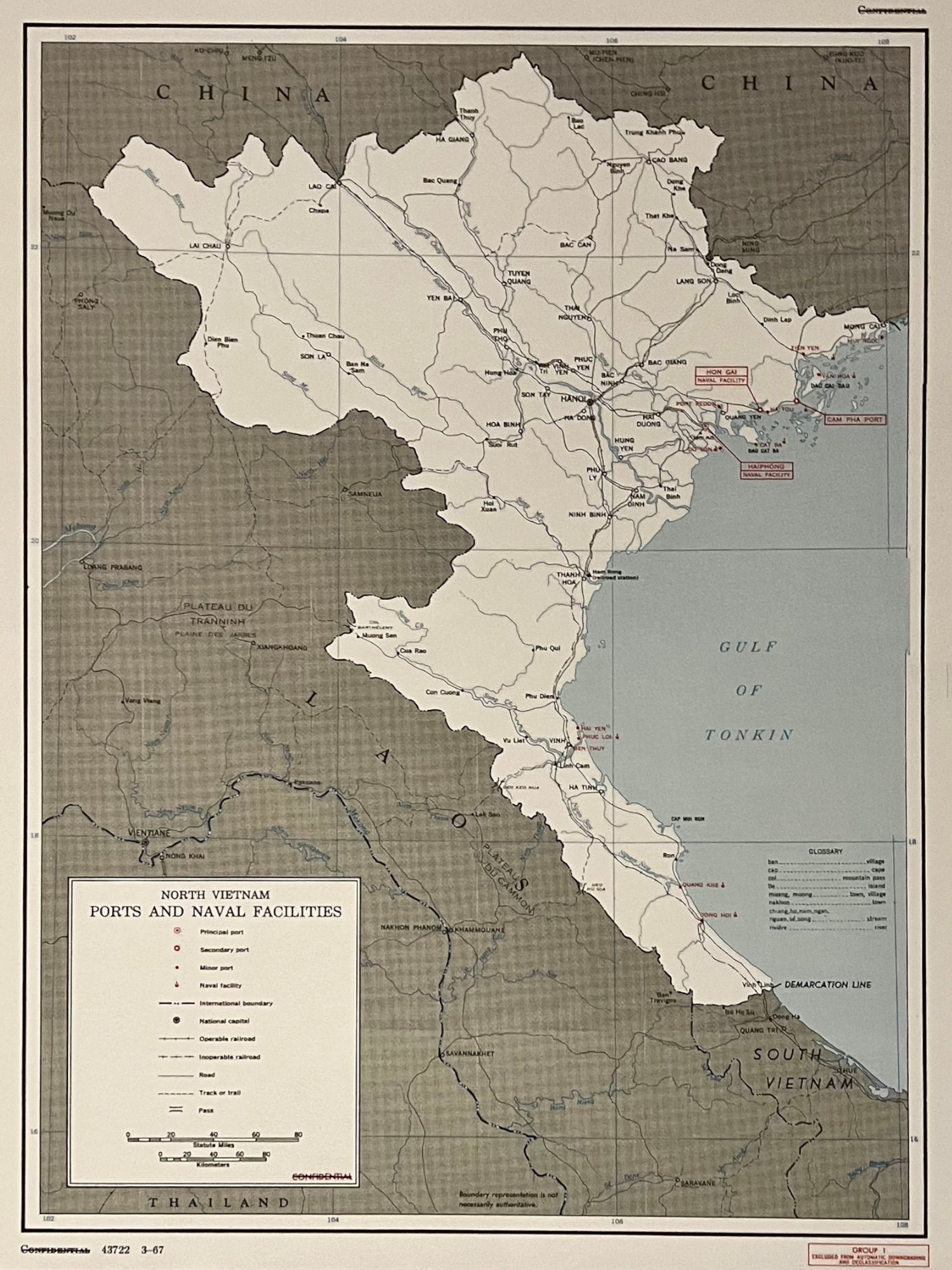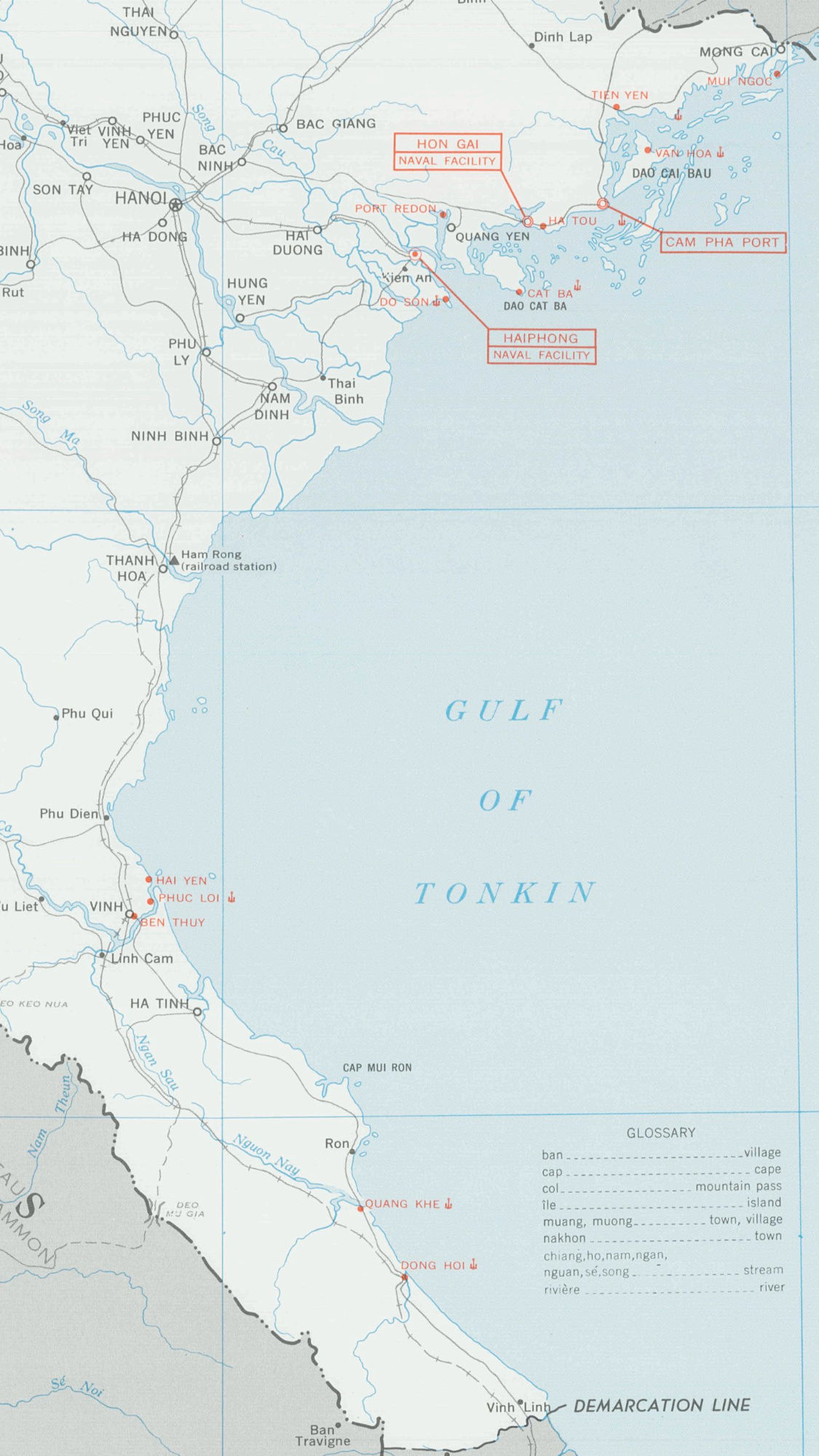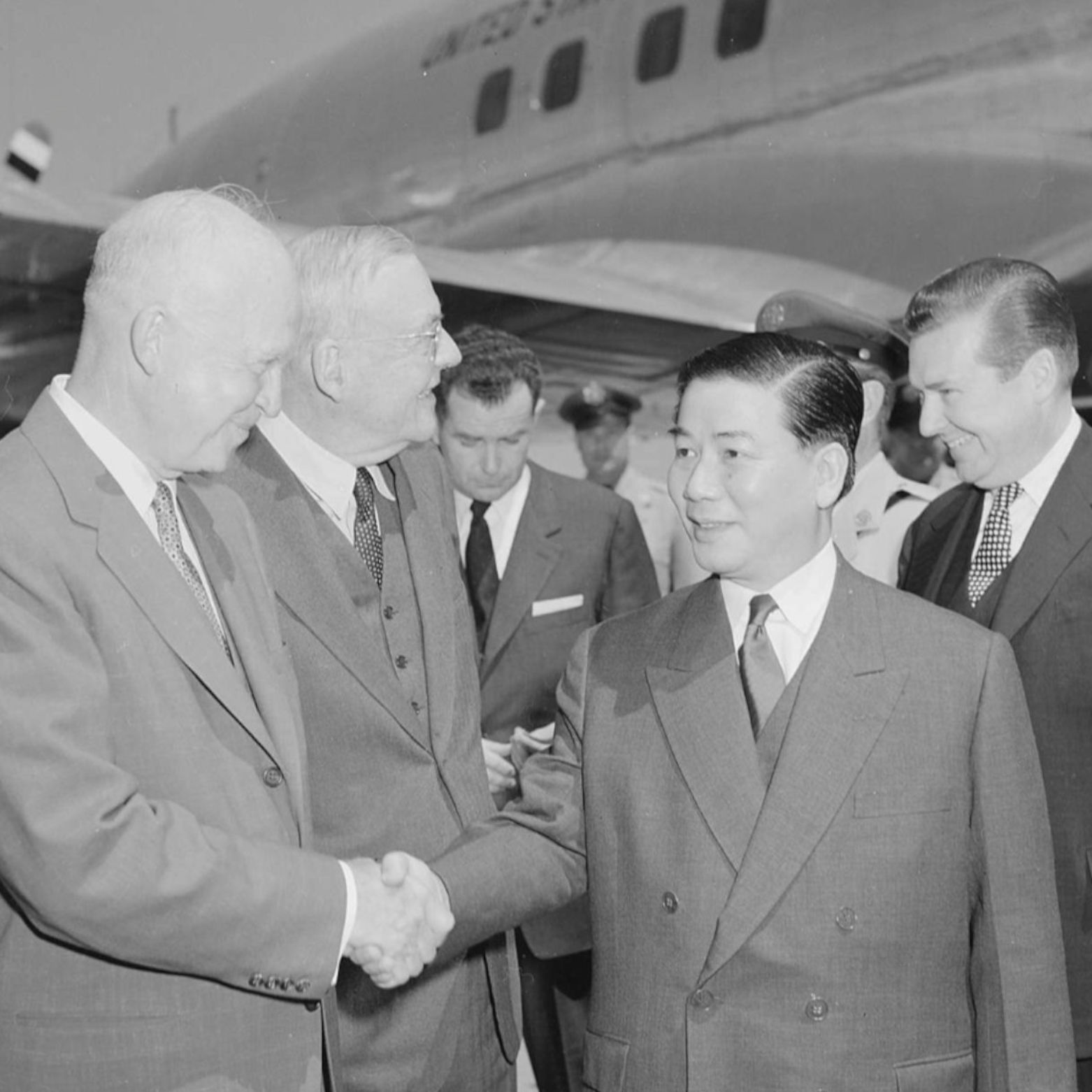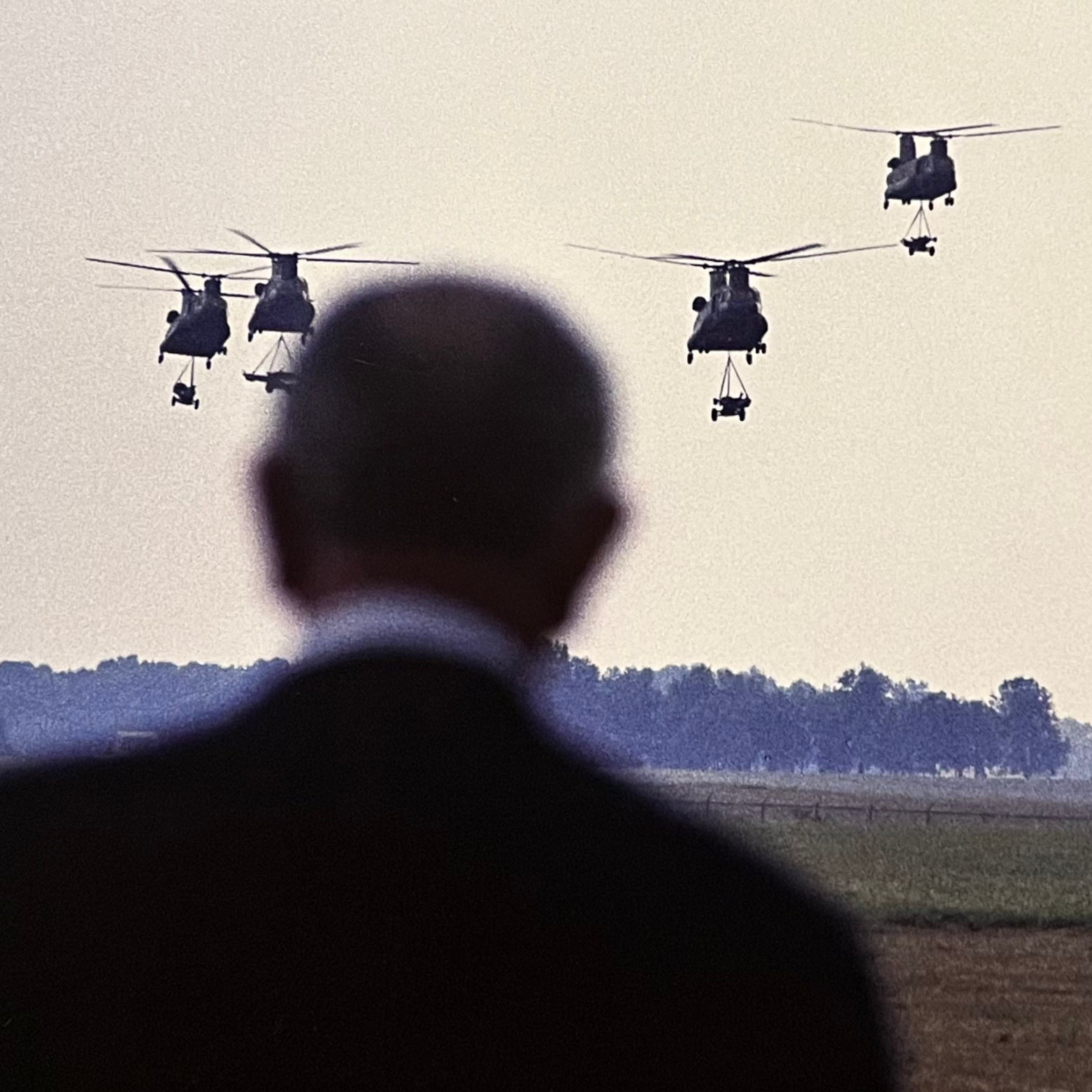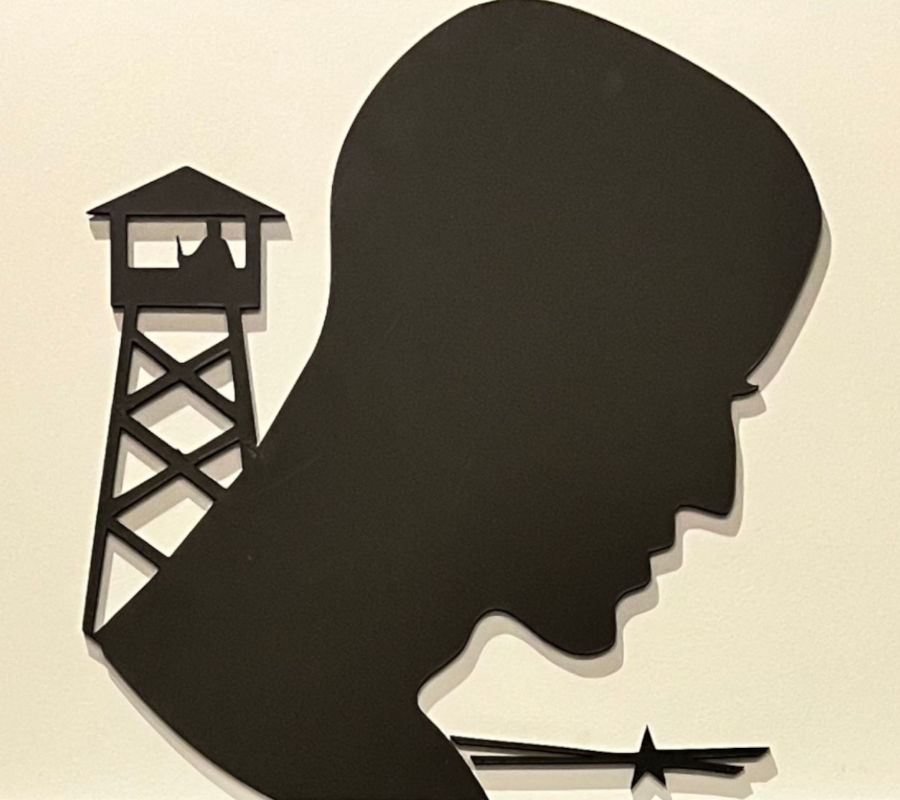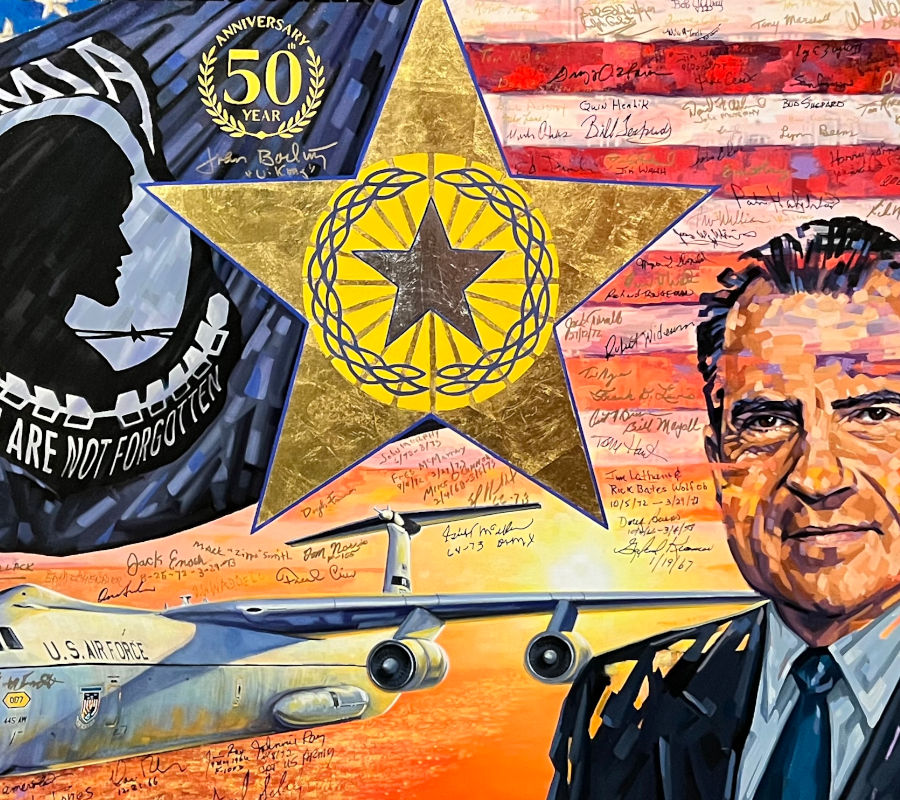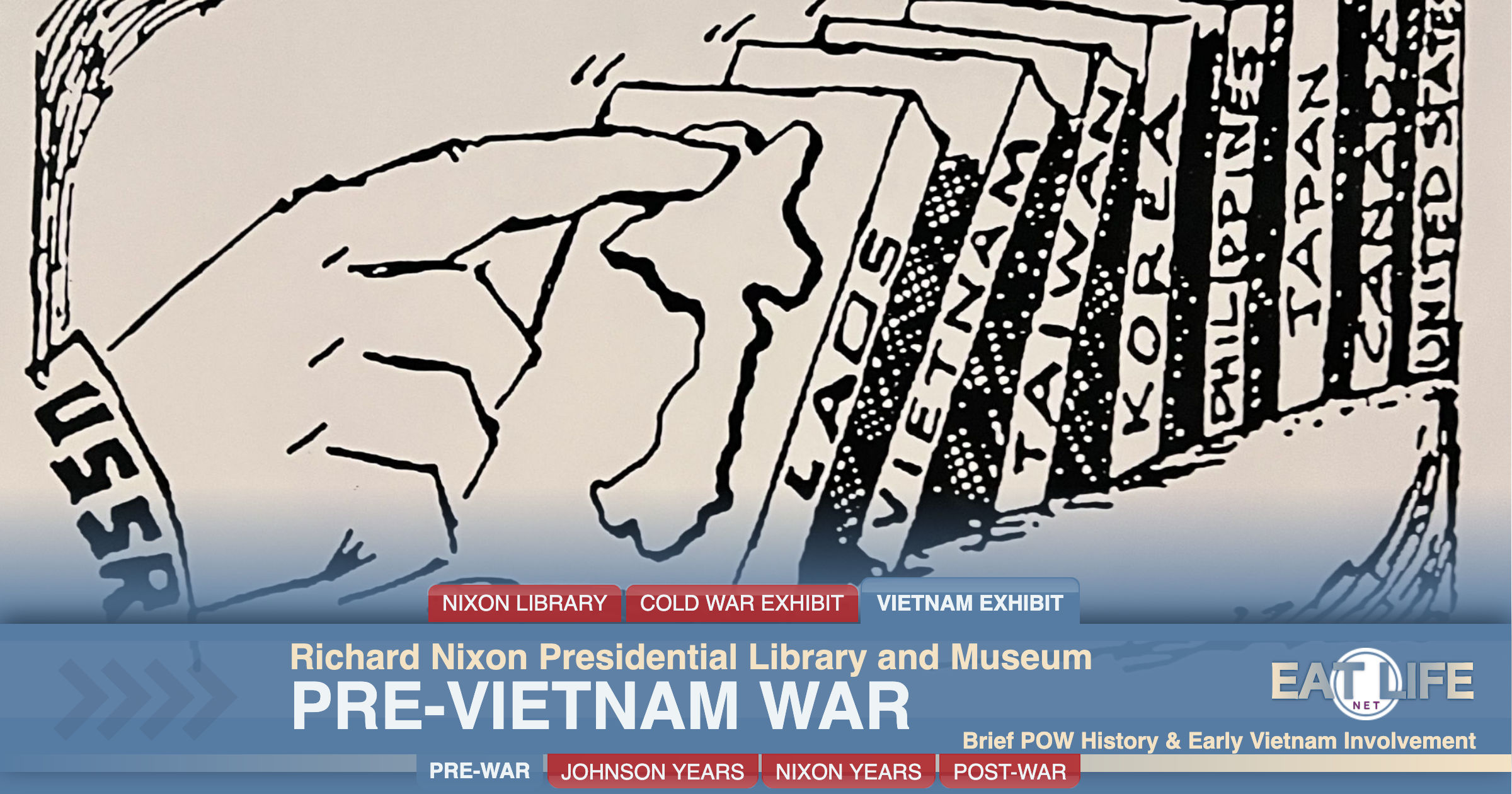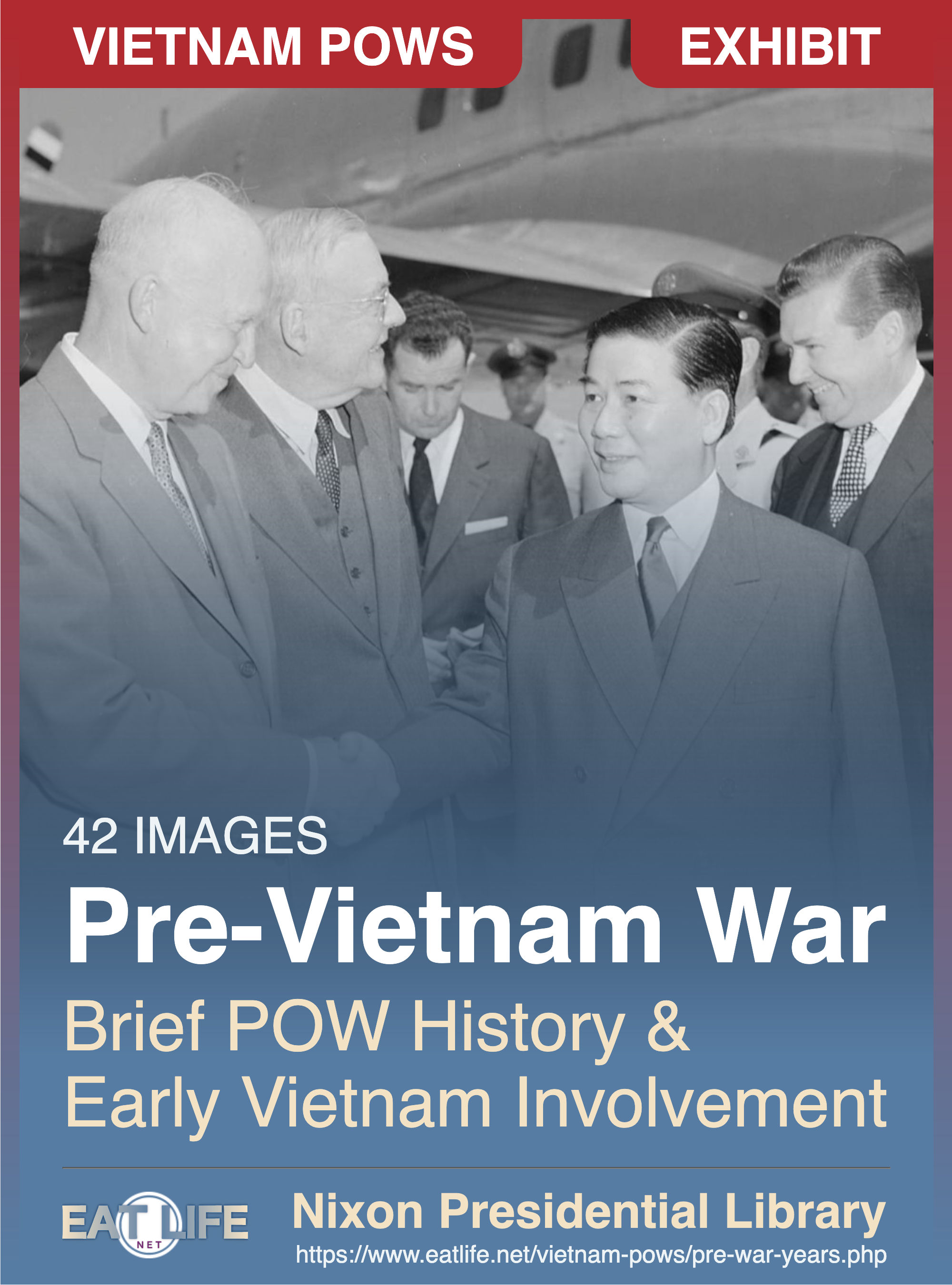VIETNAM EXHIBIT:
| PRE-VIETNAM WAR: | |
|---|---|
| ON THIS PAGE | |
| What is a POW? | |
| 1775 | American Revolution POWs |
| 1812 | War of 1812 POWs |
| 1865 | Civil War POWs |
| 1917 | World War I POWs |
| 1920 | Ho Chi Minh |
| 1941 | World War II POWs |
| 1942 | World War II Japanese Internment |
| 1945 | Brief History of Vietnam |
| 1947 | Truman Doctrine |
| 1949 | Geneva Conventions |
| 1950 | Korean War POWs |
| 1954 | Indochina Communist Expansion |
| 1954 | 17th Parallel |
| 1955 | POW Code of Conduct |
| 1963 | Tiger Cages |
What is a POW?
For as long as there has been warfare, there have been prisoners of war. Any combatant captured by his or her country's enemy is considered a prisoner of war.
- In ancient times, prisoners of war were routinely enslaved or executed.
- In the Middle Ages, prominent or wealthy POWs were often held for ransom. Those of lower status were usually executed to avoid costs associated with holding them.
It wasn't until the 1600s that POWs began to be treated less harshly. Nevertheless, American POWs have endured forced labor, physical and psychological torture, inadequate nutrition, and poor medical care.
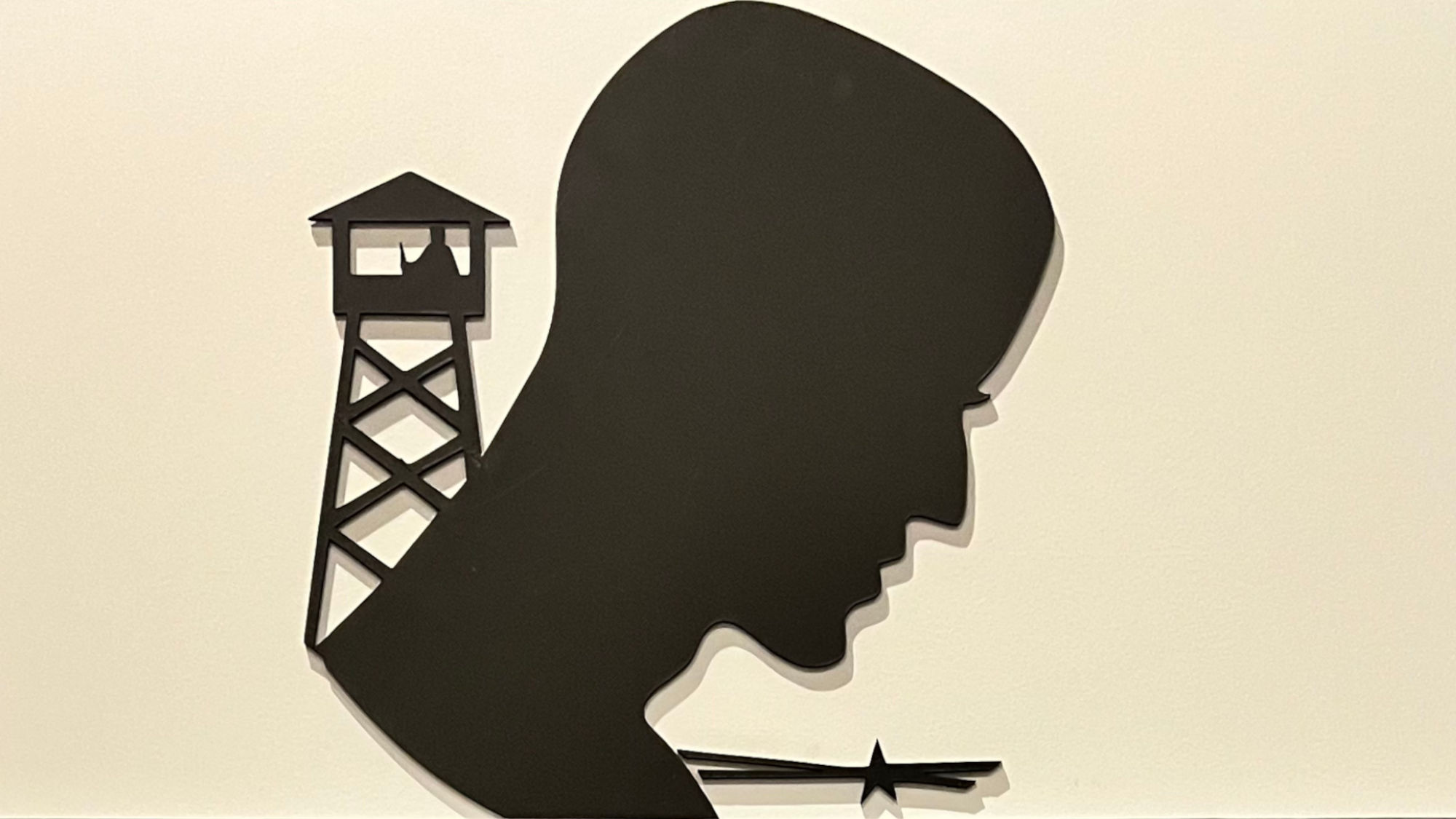
POWs in the American Revolution
Prisoners of war captured by the British were treated harshly. The British did not consider the men they captured to be POWs. Instead, they considered them to be criminals and traitors to the British Crown
Most American POWs were held in British prison ships. These ships were docked in waters off of New York, South Carolina, and St. Lucia in the West Indies. Prisoners who died were tossed overboard. In some cases, they were taken ashore and buried in shallow graves.
Among the most notorious of the prison ships was the HMS Jersey. Ironically, it was a former hospital ship. Alexander Coffin, twice imprisoned on the Jersey, recalled that prisoners existed in
and scarcely clothes to cover their nakedness, and overrun with lice from head to feet.
An estimated 8,500 died in captivity.
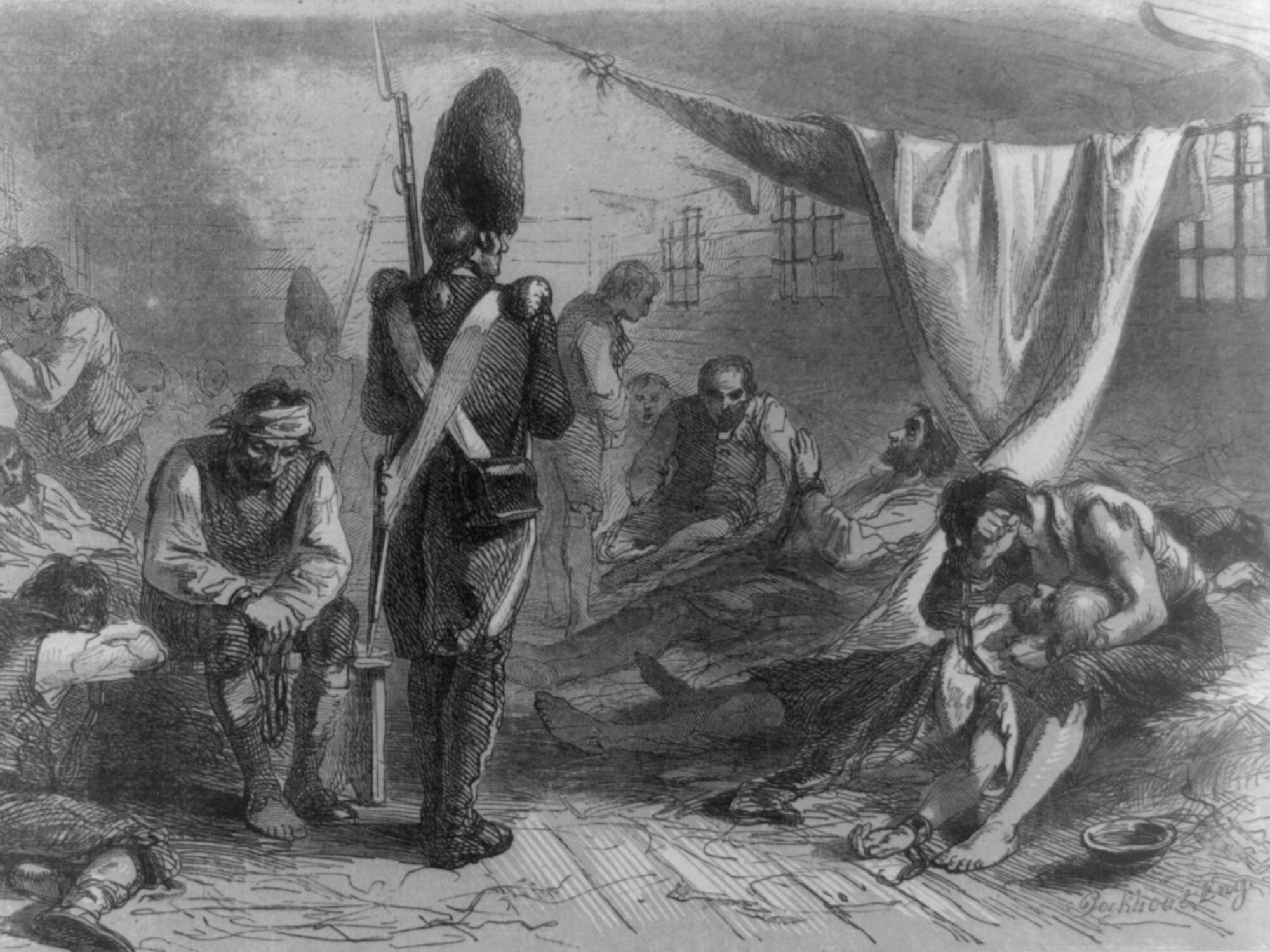
HMS Jersey
American Revolution
This engraving by Felix Darley reflected the brutal conditions aboard the HMS Jersey.
POWs in the War of 1812
When war against the British broke out again in 1812, American POWs fared no better than their counterparts during the American Revolution. In the early months of the war, prisoners were held on British ships. But beginning in 1813, they were transported to England. There, they were held under deplorable conditions in British prisons.
Charles Andrews was one of the more than 5,000 POWs held in the notorious Dartmoor Prison. He wrote of the terrible conditions he endured.
Ironically, an effort to win the release of a 65-year-old Maryland physician held as a prisoner by the British would produce one of the most enduring songs in American history.
During the evening of September 12, 1812, Francis Scott Key was detained aboard the Royal Navy warship, HMS Tonnant, during the withering attack on Fort McHenry in Baltimore Harbor. Key had boarded the ship in order to negotiate the release of the doctor who had been arrested by British troops.
As dawn broke, Key saw that the American flag was still flying over the embattled fort. He wrote a poem that was published under the title, Defence of Fort M'Henry. Key's verse would, 119 years later, be adopted as America's national anthem, The Star-Spangled Banner.
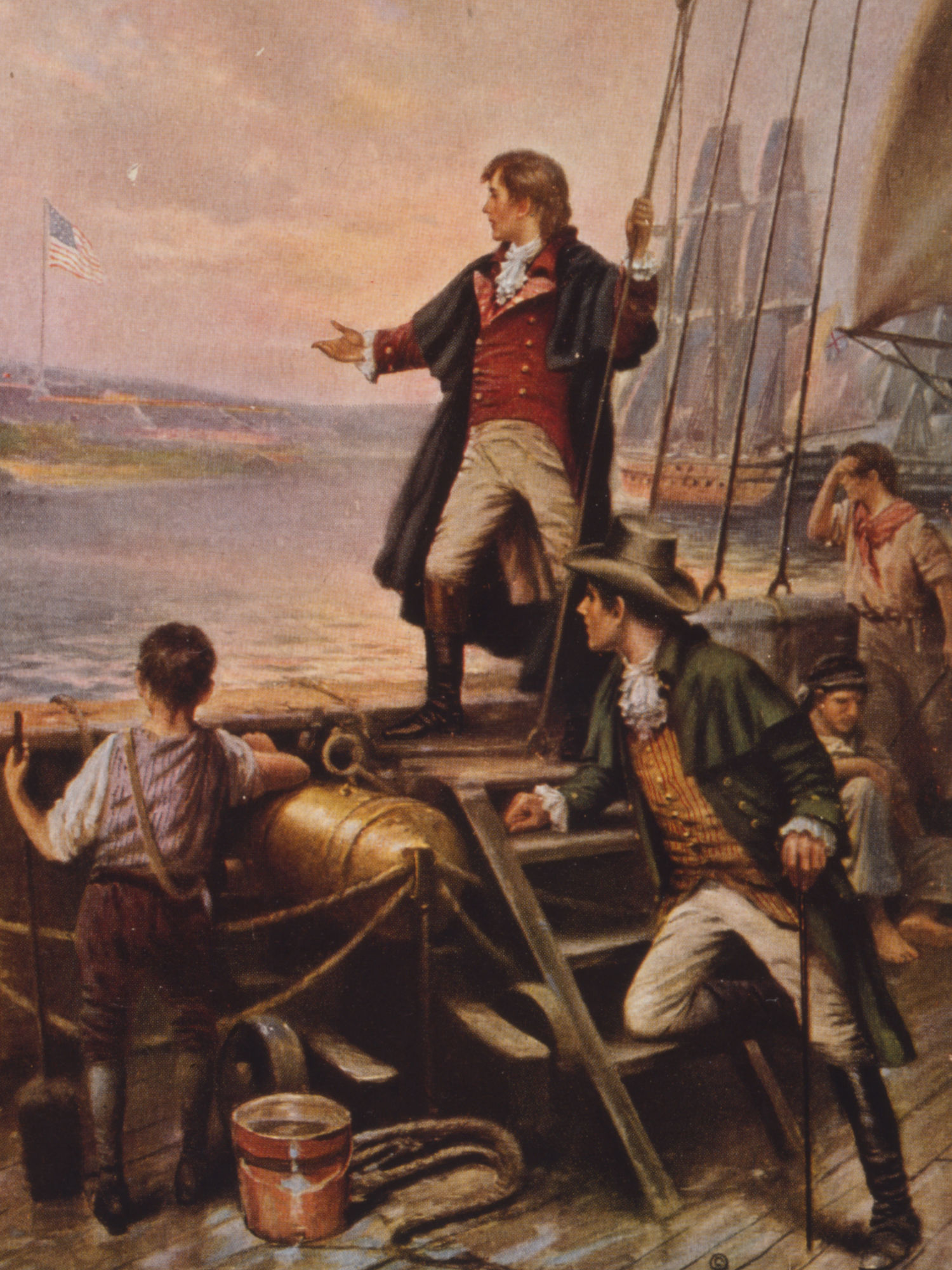
The Star Spangled Banner
From the bow of a British ship, Francis Scott Key witnessed the long nighttime bombardment of Fort McHenry in Baltimore Harbor.
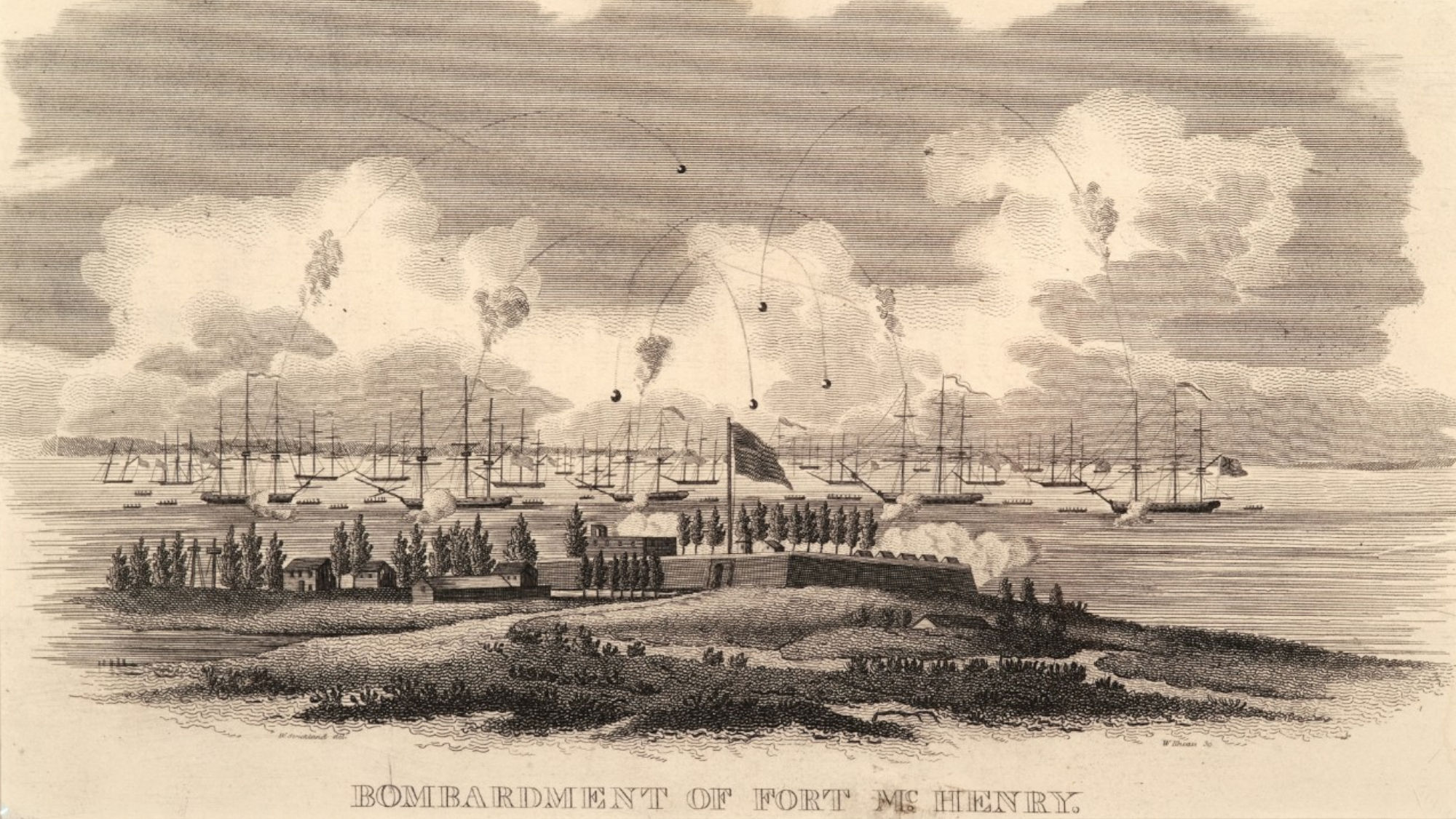
Bombardment of Fort McHenry
Engraving by William Kneass
A line engraving depicting the bombardment of Fort McHenry by the British during the War of 1812.
- The Stars and Stripes can be seen flying at the fort's center
Defence of Fort M'Henry
By Francis Scott Key
September 12, 1812
O! say can you see, by the dawn's early light,
What so proudly we hail'd at the twilight's last gleaming,
Whose broad stripes and bright stars through the perilous fight,
O'er the ramparts we watch'd, were so gallantly streaming?
And the rockets' red glare, the bombs bursting in air,
Gave proof through the night that our flag was still there -
O! say, does that star-spangled banner yet wave
O'er the land of the free, and the home of the brave?
On the shore, dimly seen through the mists of the deep,
Where the foe's haughty host in dread silence reposes,
What is that which the breeze o'er the towering steep,
As it fitfully blows, half conceals, half discloses?
Now it catches the gleam of the morning's first beam,
In full glory reflected now shines on the stream -
'Tis the star-spangled banner, O! long may it wave
O'er the land of the free, and the home of the brave.
And where is that band who so vauntingly swore
That the havock of war and the battle's confusion
A home and a country should leave us no more?
Their blood has wash'd out their foul foot-steps' pollution,
No refuge could save the hireling and slave,
From the terror of flight or the gloom of the grave;
And the star-spangled banner in triumph doth wave
O'er the land of the free, and the home of the brave.
O! thus be it ever when freemen shall stand
Between their lov'd home, and the war's desolation,
Blest with vict'ry and peace, may the heav'n-rescued land
Praise the power that hath made and preserv'd us a nation!
Then conquer we must, when our cause it is just,
And this be our motto - "In God is our trust!"
And the star-spangled banner in triumph shall wave
O'er the land of the free, and the home of the brave.
POWs in the Civil War
The Civil War was the deadliest war in American history. It also produced the largest number of prisoners of war. As many as 408,000 soldiers were imprisoned during the war. Upwards of 194,000 Union soldiers, and as many as 214,000 Confederate soldiers, were held as POWs.
Conditions for POWs on both sides of the conflict were brutal.
- About 30,000 Union troops died while being held.
- Some 26,000 Confederate troops died in Union POW camps.
The most notorious of the POW camps was located in Georgia. Andersonville was a small agricultural town with a population fewer than 500. More than 13,000 Union prisoners died in captivity in Andersonville. Forty-three percent of all Union deaths in Confederate POW camps occurred in Andersonville.
At the end of the war, President Abraham Lincoln issued a blanket pardon for members of the Confederate military. The commander of Andersonville, Henry Wirz, was excluded from that pardon. Wirz was executed due to the deplorable treatment and murder of prisoners held in his camp.
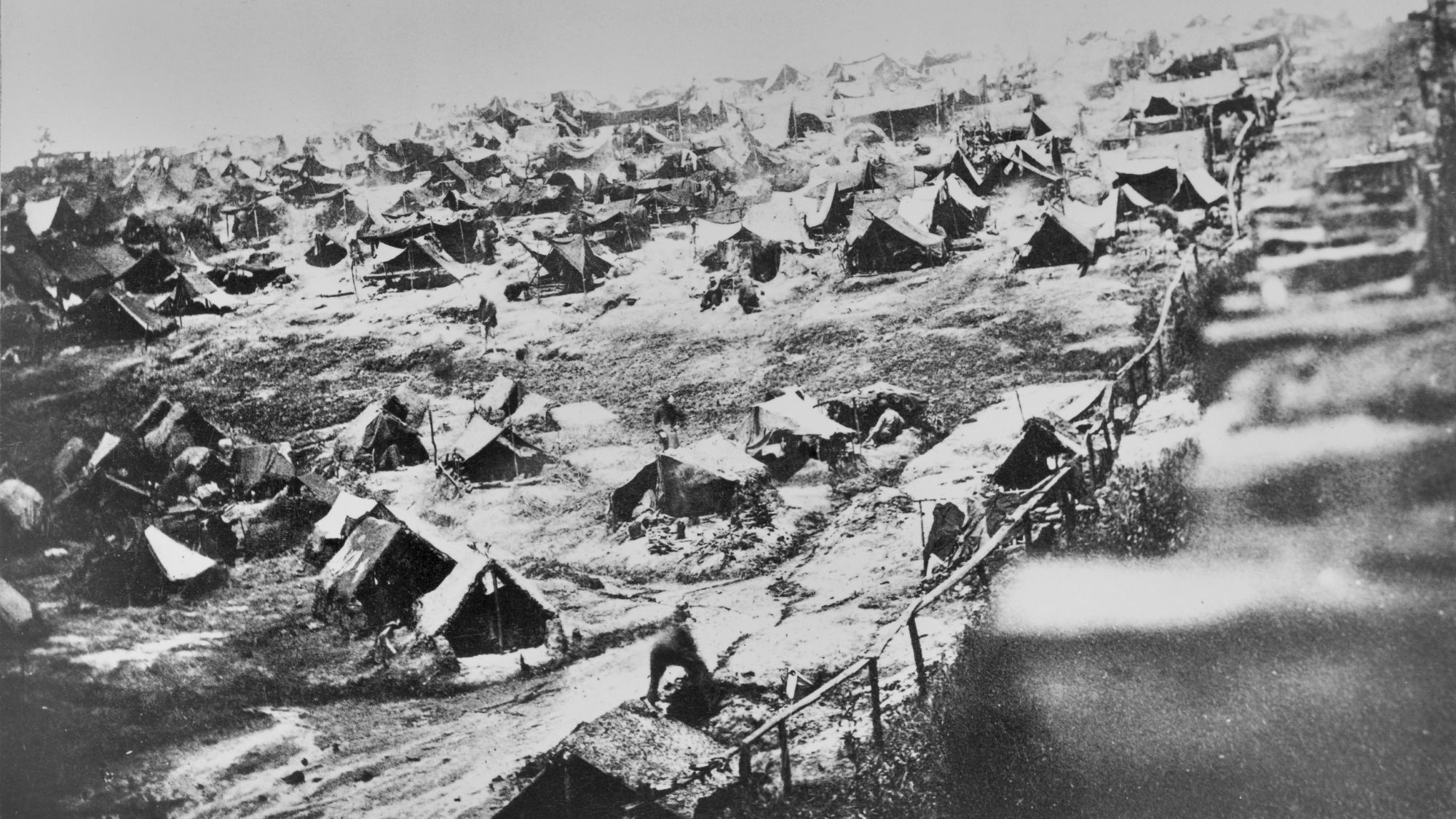
POW Tents
Andersonville Prison
Georgia's Andersonville prison housed Union prisoners of war held by the Confederacy. The awful conditions inside led to its reputation as a prison camp of death.
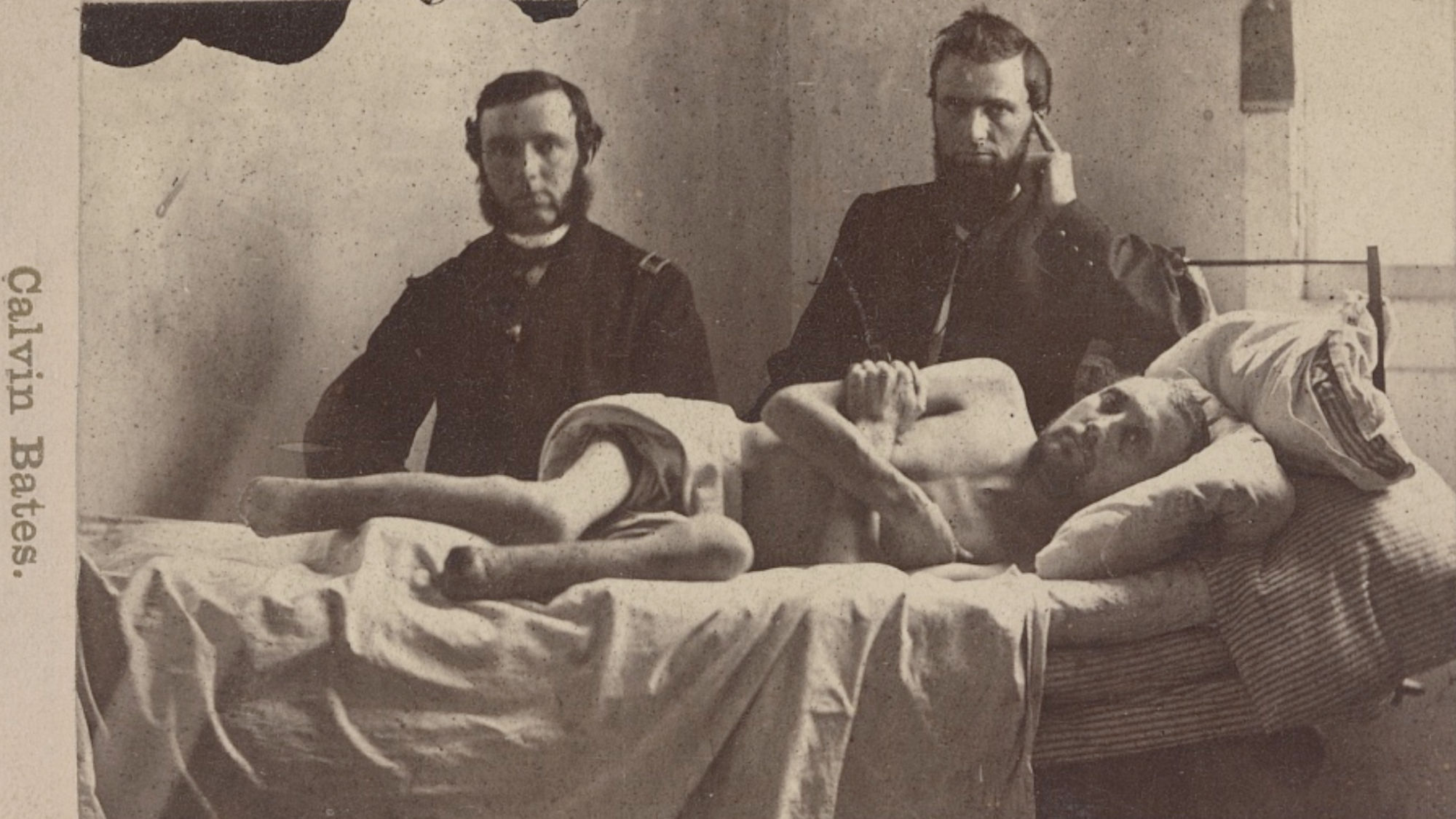
Corporal Calvin Bates
Andersonville Prison
Corporal Calvin Bates was imprisoned at Andersonville. The lack of medical treatment available for prisoners resulted in the decay and eventual amputation of his feet.
Calvin Bates Deposition
County of Westchester, State of New-York
Calvin Bates, a Corporal in Company E, 20th Regt, Me. Vols, being duly sworn doth depose and say that he was mustered into the service of the United States in said company and regiment August 29, 1862; was taken prisoner at the "Wildeness" Va., May 5, 1864; and was in Andersonville military prison, Ga from 23d day of May 1864, to Sept. 12, 1864. And this deponent further says that he and his fellow prisoners were totally unprovided with any shelter from the inclemency of the weather except such as they could make for themselves by partially burrowing in the ground, and by reason of such exposure and other inhumanities practiced upon him at said prison, his feet decayed so that both of them have since been cut off at the ankle with scissors, by Dr. A.J. Smith, six weeks subsequently the bones protruding amputation was performed, and that previous to said imprisonment at Andersonville, he was a well healthy man, and further this deponent saith not.
Calvin Bates.
Subscribed and sworn before me this 28th day of April, 1865.
Thos. P. How, Notary Public
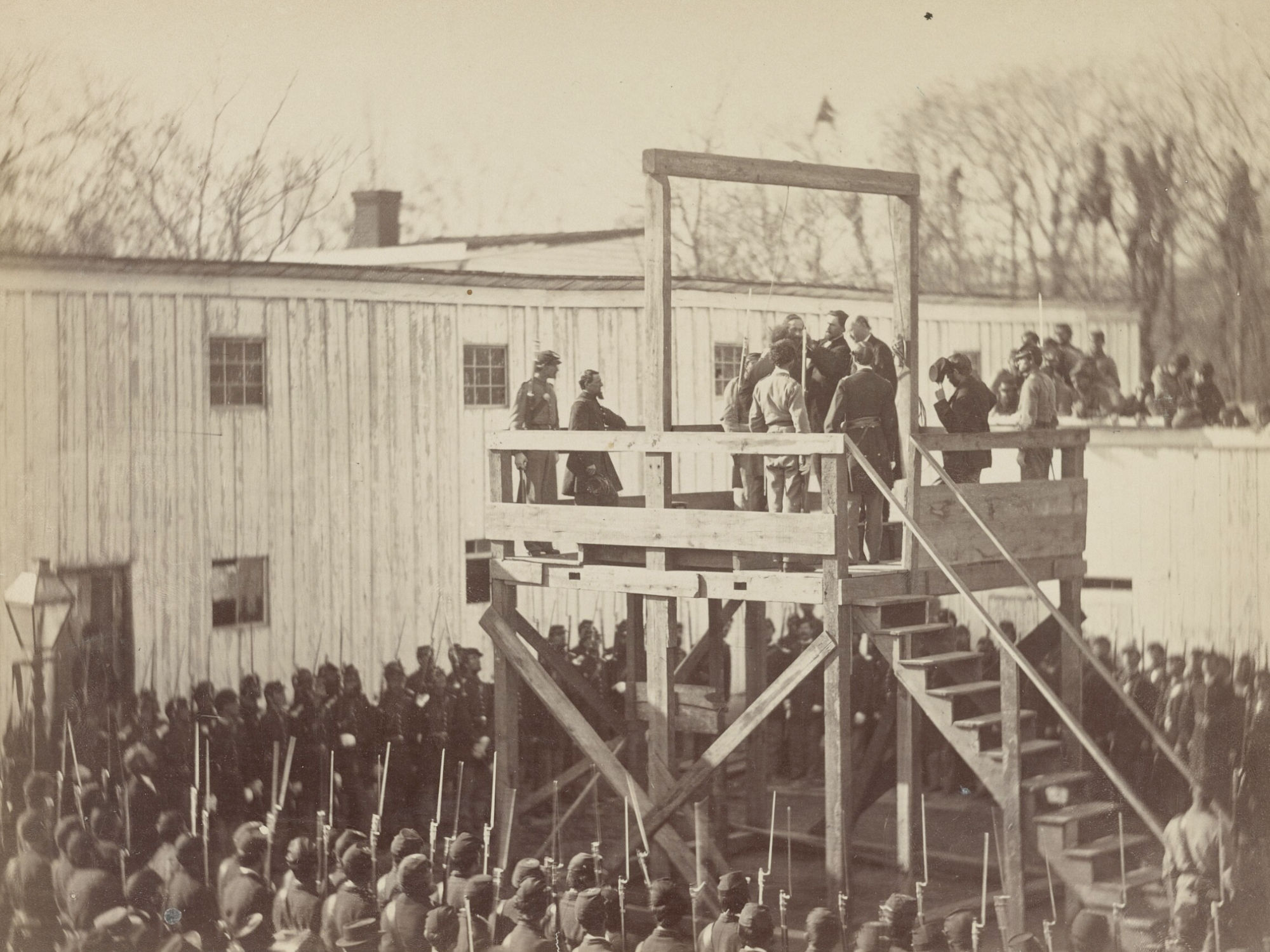
Henry Wirz
Old Capitol Prison, Washington, D.C.
- Adjusting the noose around Wirz's neck
Confederate Captain Henry Wirz was held responsible for the deplorable conditions at the camp that led to thousands of POW deaths at Andersonville. After a trial, he was executed on November 10, 1865.
WIKIPEDIAHartmann Heinrich Wirz
Swiss-American who served as a Confederate Army officer during the American Civil War. He was the commandant of Andersonville Prison, a Confederate prisoner-of-war camp near Andersonville, Georgia, where nearly 13,000 Union Army prisoners of war died as a result of inhumane conditions. After the war, Wirz was tried and executed for conspiracy and murder relating to his command of the camp; this made the captain the highest-ranking soldier and only officer of the Confederate Army to be sentenced to death for crimes during their service.In February 1864, the Confederate government established Camp Sumter, a large military prison near the small railroad depot of Anderson (now Andersonville) in south-western Georgia, built to house Union prisoners-of-war. In April 1864, Wirz arrived at Camp Sumter and remained there for over a year holding the post of commandant of the stockade and its interior.
Camp Sumter had not been constructed to its full plan, and was quickly overwhelmed by the influx of Union prisoners. Though wooden barracks were originally planned, the Confederates incarcerated the prisoners in a vast, rectangular, open-air stockade originally encompassing 16.5 acres, which had been intended as only a temporary prison pending exchanges of prisoners with the Union. The prisoners gave this place the name "Andersonville", which became the colloquial name for the camp. Camp Sumter suffered from severe overcrowding, poor sanitary conditions, and an extreme lack of food, tools, medical supplies, and potable water.
At its peak in August 1864 after its expansion to 26 acres, the prison held some 33,000 Union prisoners - around four times more than any other Confederate prison - with little more than patchy tents for shelter. The same summer saw more than 100 prisoners die of disease, exposure, or malnutrition every day. Around 45,000 prisoners were incarcerated during the camp's 14-month existence, of whom close to 13,000 (28%) died.
- Wirz was arrested by a contingent of the 4th U.S. Cavalry on May 7, 1865, in Andersonville.
- The federal government decided to put him on trial for conspiring to impair the lives of Union prisoners of war
- In early November 1865, the Military Commission found Wirz guilty of conspiracy as charged, along with 10 of 13 specifications of acts of personal cruelty, and sentenced him to death.
- The military tribunal took place between August 23 and October 18, 1865, was held in the United States Court of Claims, and dominated the front pages of newspapers across the United States.
- Wirz was hanged at 10:32 a.m. on November 10, 1865, at the Old Capitol Prison in Washington D.C., located next to the U.S. Capitol.
POWs in World War I
World War I had been raging in Europe since 1914. American forces, however, did not begin to arrive until June 1917. They didn't arrive on the frontlines until October. The fighting ended 13 months later on November 11, 1918.
Consequently, the number of American prisoners held by the Germans was relatively low: approximately 4,120. Ninety-six percent of American POWs returned home at the end of the war. In contrast, Britain, which had entered the war at its start, had more than 170,000 POWs captured by the German army. More than 11,000 British prisoners died in German captivity.
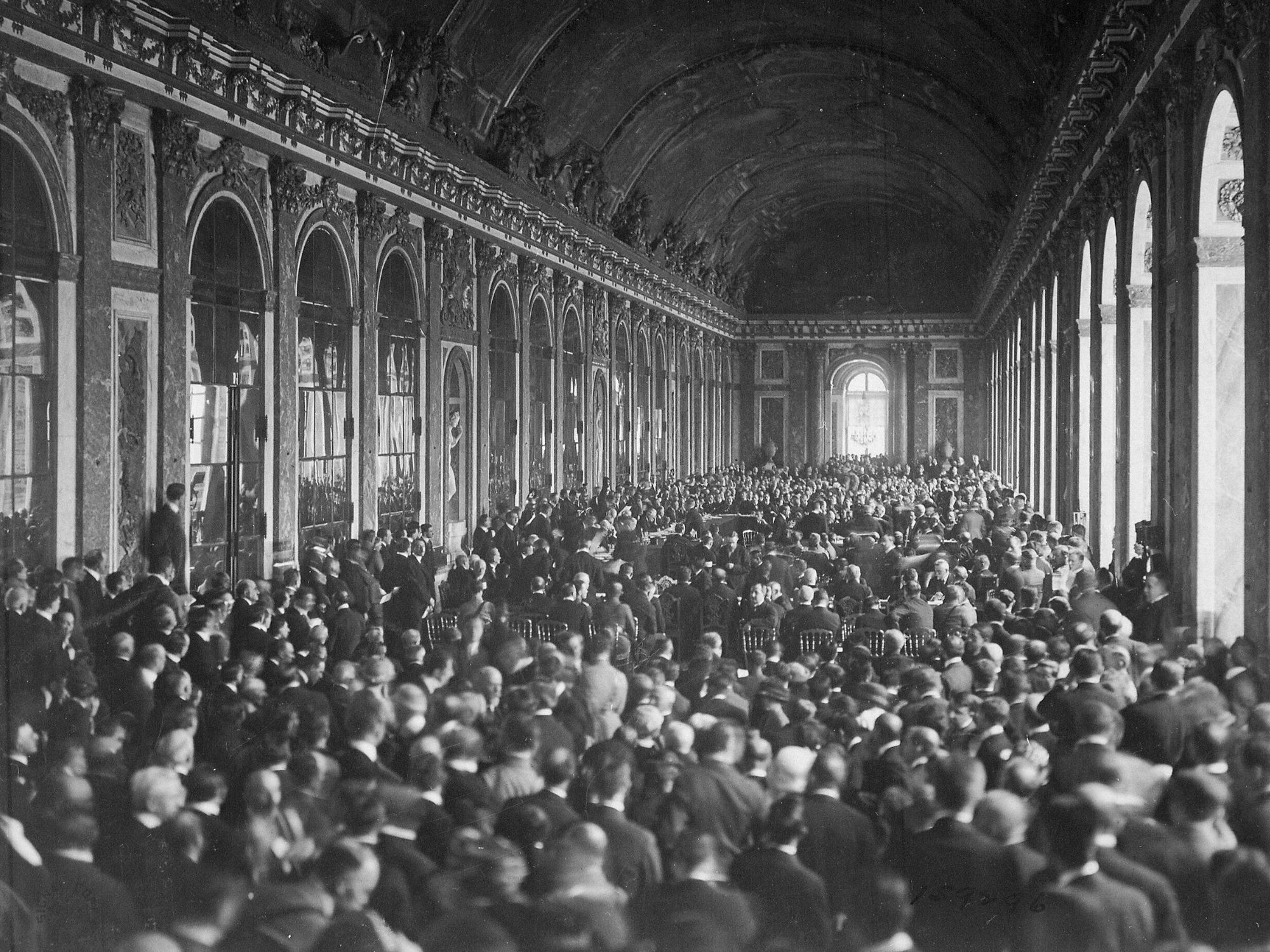
Treaty of Versailles
Peace agreement between Germany and the Allied Powers
A huge crowd witnesses the signing of the Treaty of Versailles near Paris, France. This ended World War I.
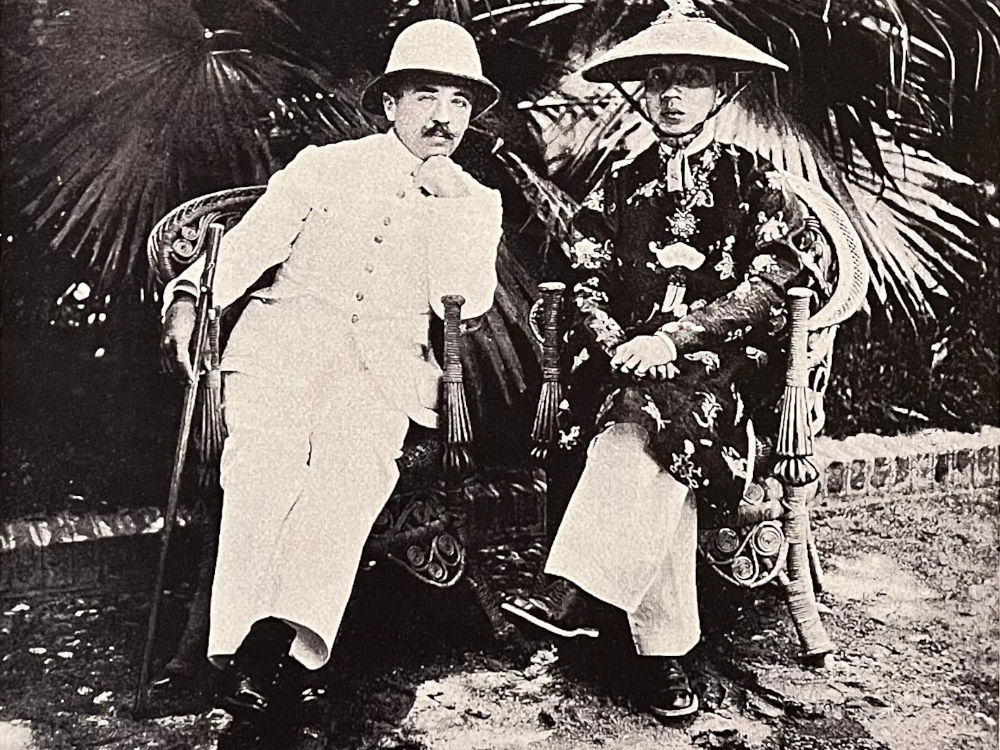
Albert Sarraut & Khai-Dinh
The French worked with local authorities to create a planter economy in Vietnam.
His Excellency Albert Sarraut, the French Governor General of Indo-China and His Majesty Khai-Dinh, Emperor of Annam pose for a portrait in 1919.
Ho Chi Minh
He was born in a rural village in one of the poorest provinces around 1890. Beginning in his early twenties, he led an almost nomadic life. In June 1911, he traveled from Vietnam to France as a cook on a French ocean liner. In the years that followed, Ho moved extensively. He visited numerous European colonies in Africa and Asia. He even lived for a time in the United States and England.
In 1920, Ho helped establish the French Communist Party. Ten years later, he organized a meeting in Hong Kong. At that meeting, the Vietnamese Communist Party was founded.
In January 1941, Ho returned to Vietnam. He then formed the League for the Independence of Vietnam.
Ho's quest to form a communist government in Vietnam was thwarted by Japan's occupation during World War II. After Japan's defeat, Ho and his comrades returned to Hanoi. On September 2, 1945, he declared Vietnam's independence.
Ho Chi Minh died on September 2, 1969. He had been called "the heart and soul of Vietnamese communism since the earliest days of the movement." Today, his preserved body is on display in a mausoleum in Hanoi.
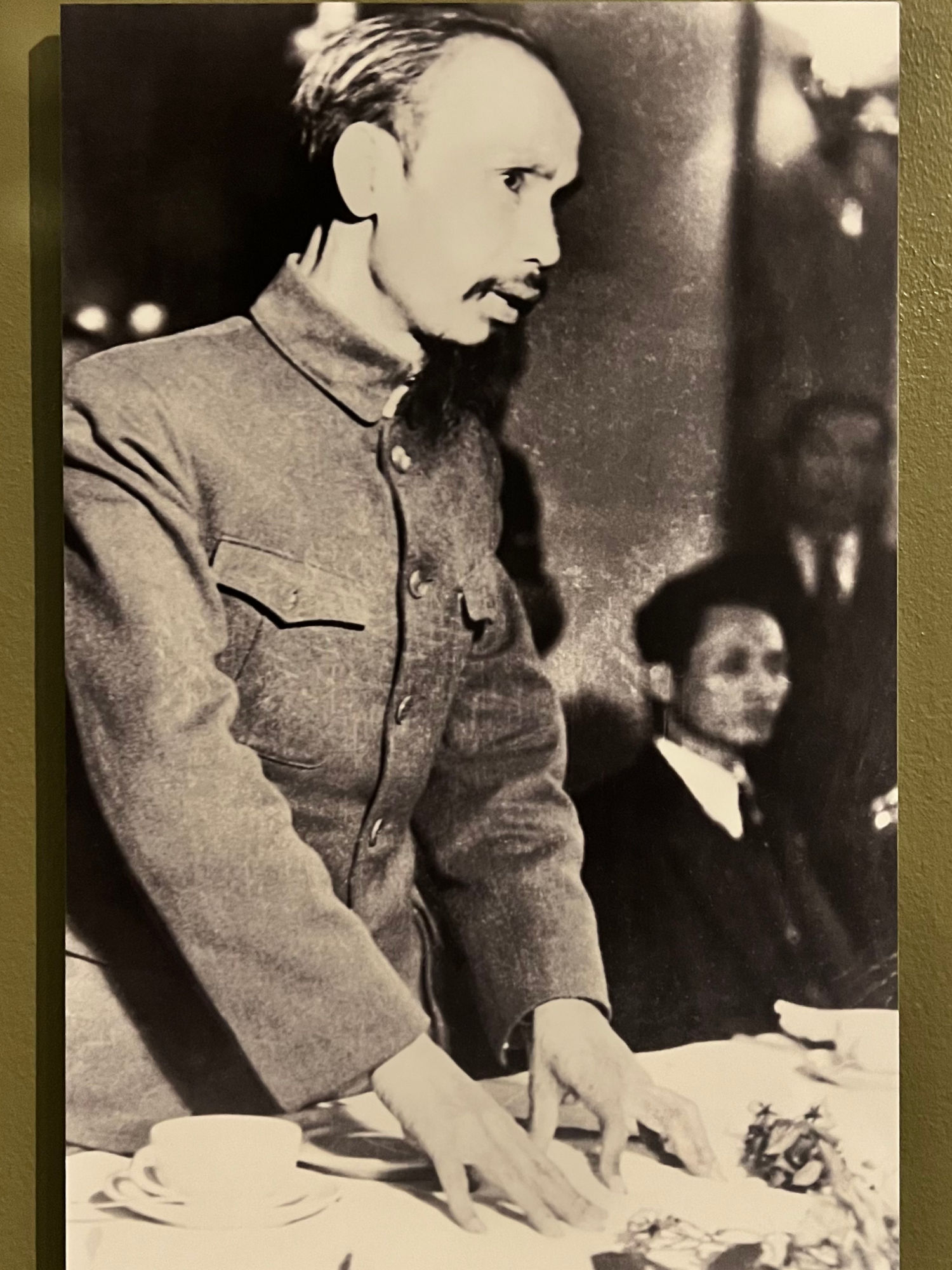
Ho Chi Minh
Vietnamese Communist Party
A young Ho Chi Minh stands up to make a point during a meeting. Ho is wearing his signature standard communist military uniform.
POWs in World War II
POWs in Europe
Americans held by the Germans endured a difficult captivity. Poor diets, overcrowding, and inadequate medical care were commonplace.
POWs in the Pacific
Conditions were far worse in Japanese POW camps. They were used as slave labor to aid Japan's war effort. One POW, Daniel Crowley, recalled,
if you objected, you were beaten to death.
Under the brutal treatment of camp commanders and guards, nearly 40 percent of those held by the Japanese died in captivity. Many were deliberately murdered as Japan's defeat grew closer.
Japanese Internment
in World War II
On December 7, 1941, Japanese air and naval forces launched a massive surprise attack on the American naval base at Pearl Harbor, Hawaii. The assault devastated the Navy's Pacific Fleet. Nineteen U.S. vessels were destroyed or damaged, including eight battleships. A total of 2,403 members of the military and civilians were killed.
The following day, President Roosevelt's request to Congress to declare war against Japan was approved within hours.
Two months later, President Roosevelt signed Executive Order 9066. It authorized the relocation to internment camps of persons thought to pose a national security risk to the United States.
In practice, this led to the loss of freedom and property of 112,000 Americans of Japanese ancestry, 70,000 of whom were U.S. citizens. None of the detainees were ever accused of disloyalty to the United States.
Small numbers of citizens of German and Italian origin were also subject to internment. But Japanese Americans were interned in far greater numbers.
This was a dark moment in American history. In 1988, Congress passed a bill apologizing and providing financial compensation to those who had wrongfully been interned.
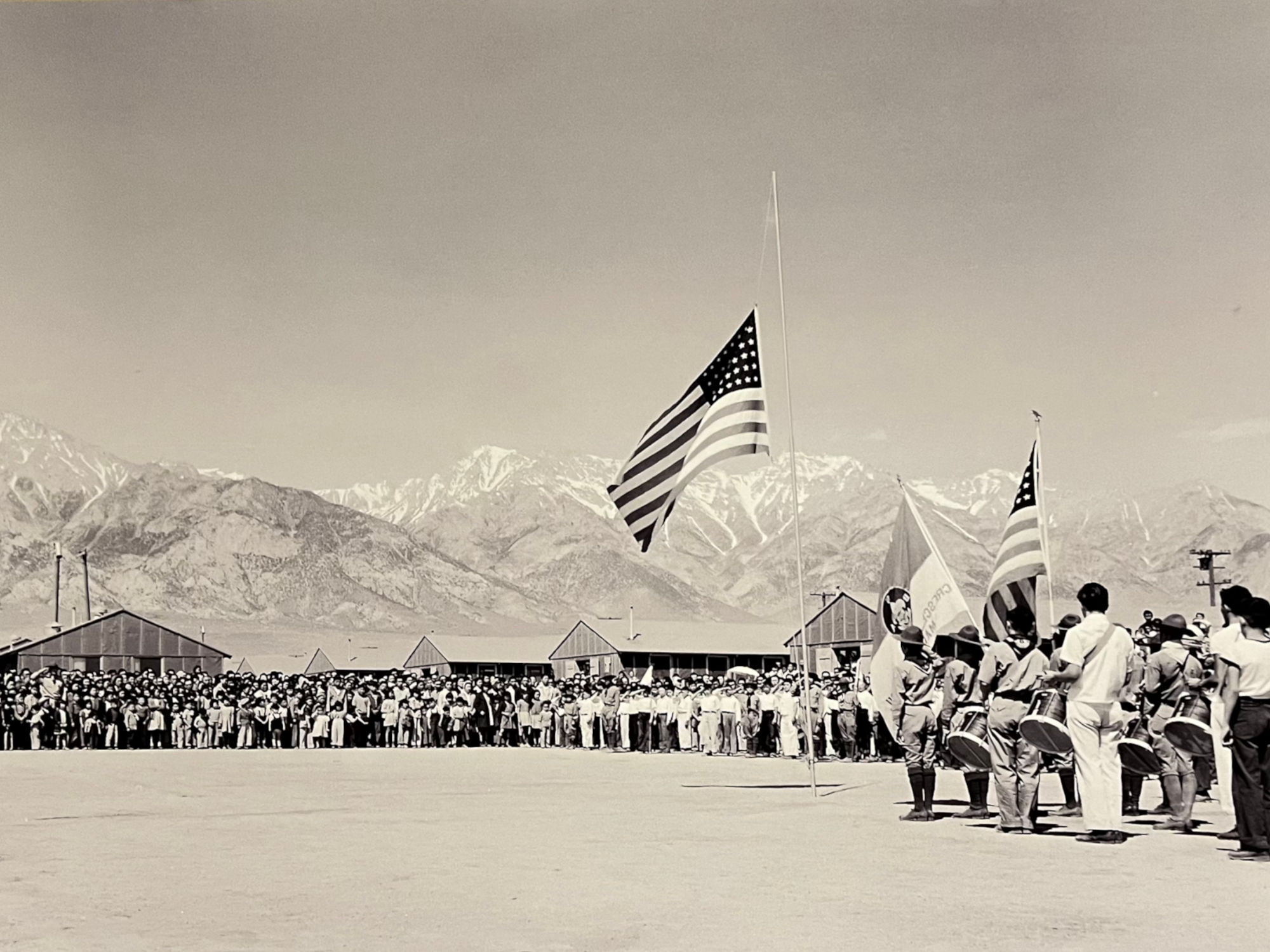
Boy Scouts
Manzanar, California
Boy Scouts Troop and American Legion members at Manzanar War Relocation Center perform Taps at a Memorial Day ceremony.
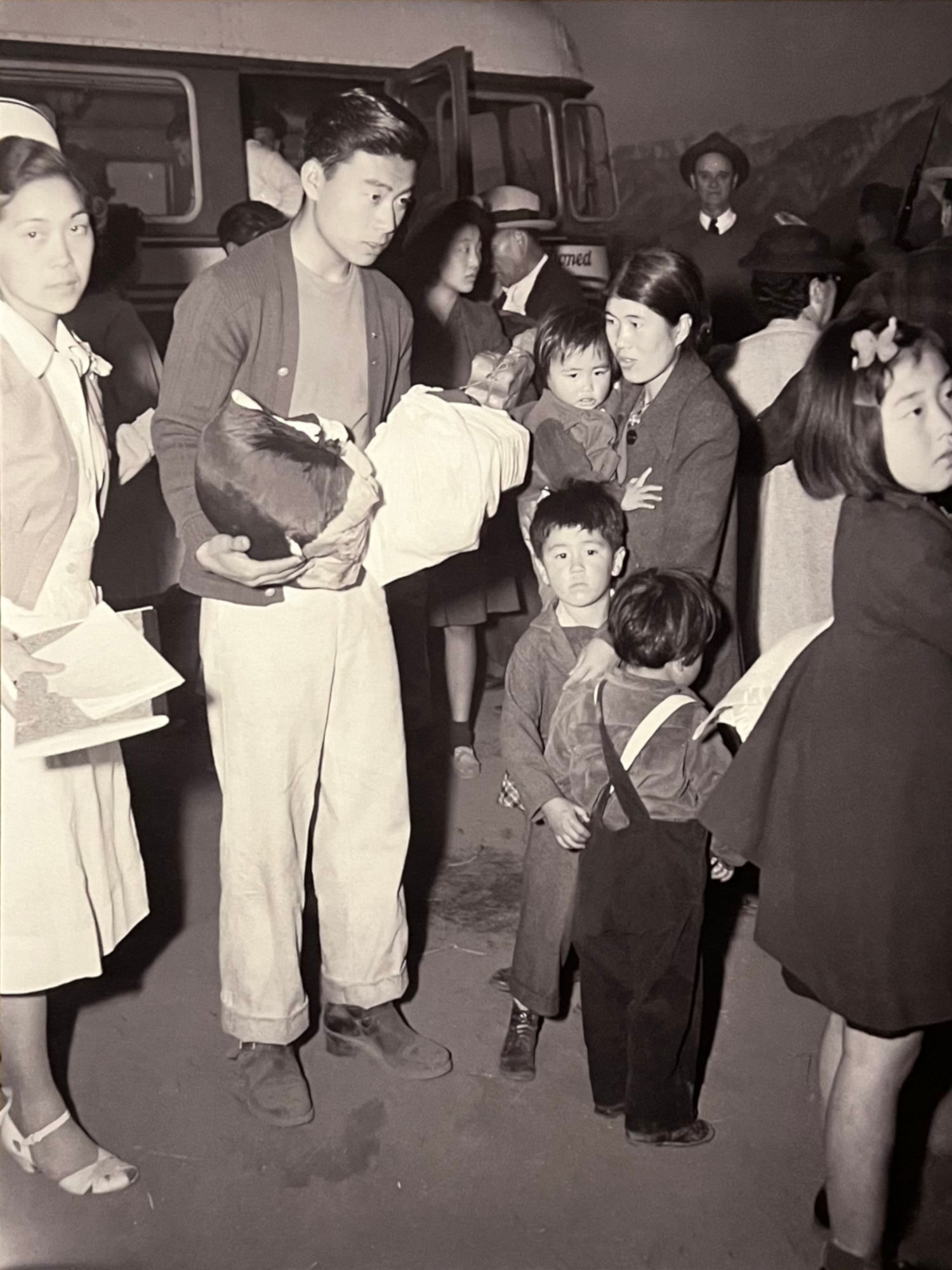
Forced to Relocate
Manzanar, California
A family of Japanese Americans arrives at Manzanar War Relocation Center, California.
One World War II POW's Story
One of the nearly 94,000 Americans held as a POW in German prisons. Serving in the U.S. Army's 103d Infantry, he was captured on December 2, 1944 while fighting in the Vosges Mountains in France.
Christianson was transported to a prison camp in southeastern Germany. There, he and his fellow POWs were forced to work during a bitterly cold winter repairing train tracks that had been bombed by the Allies. In April 1945, Christianson escaped from captivity. He walked for seven days to Czechoslovakia. The Czech resistance kept him hidden until the end of the war.
For injuries suffered as a POW, Christianson received a Purple Heart. After returning home to the United States, he married and settled in New jersey. He and his wife raised five children. Christianson died at age 52 as a result of the mistreatment he suffered during his captivity.
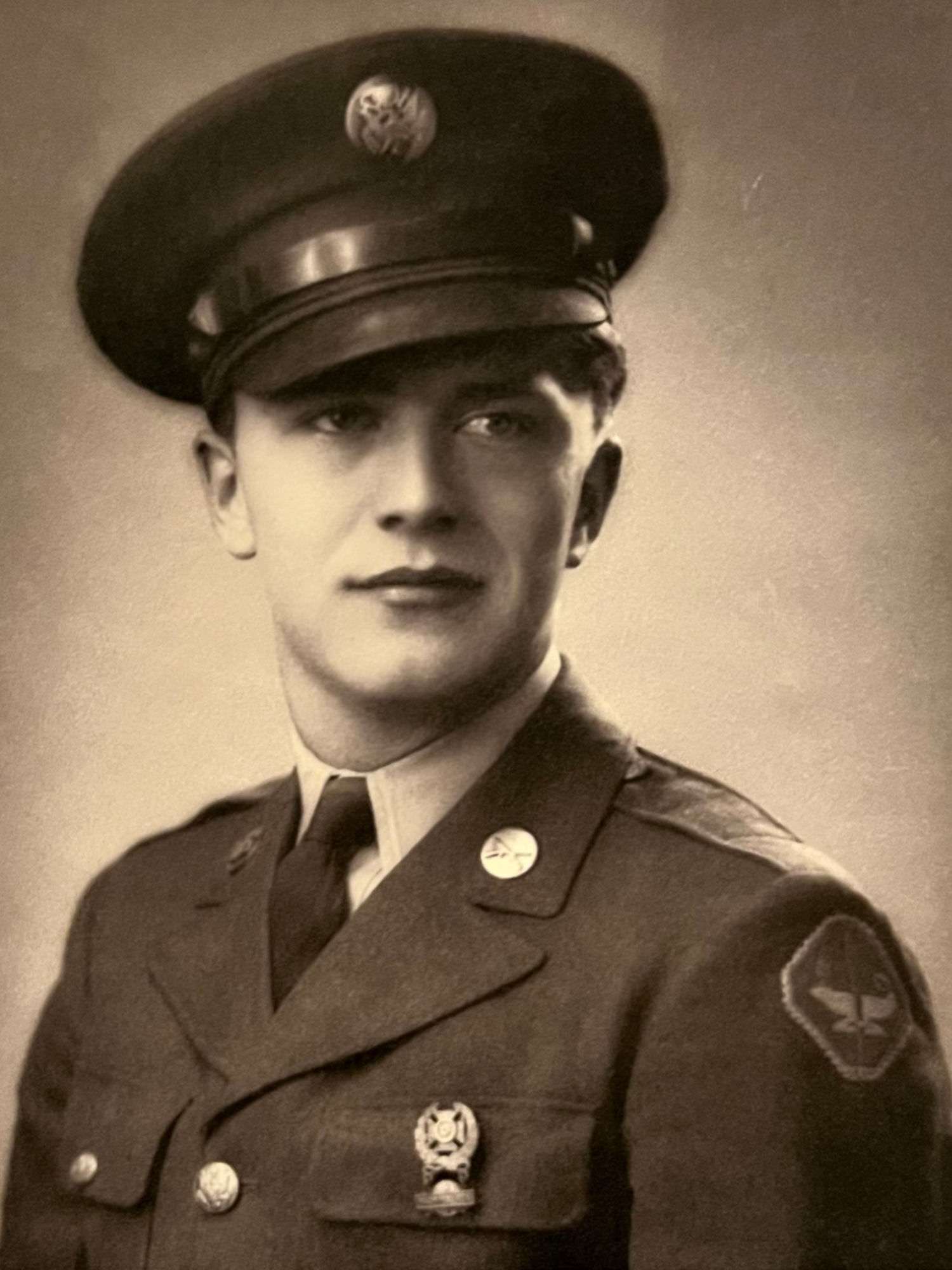
Robert Christianson
The official Army portrait of Private First Class Robert Christianson
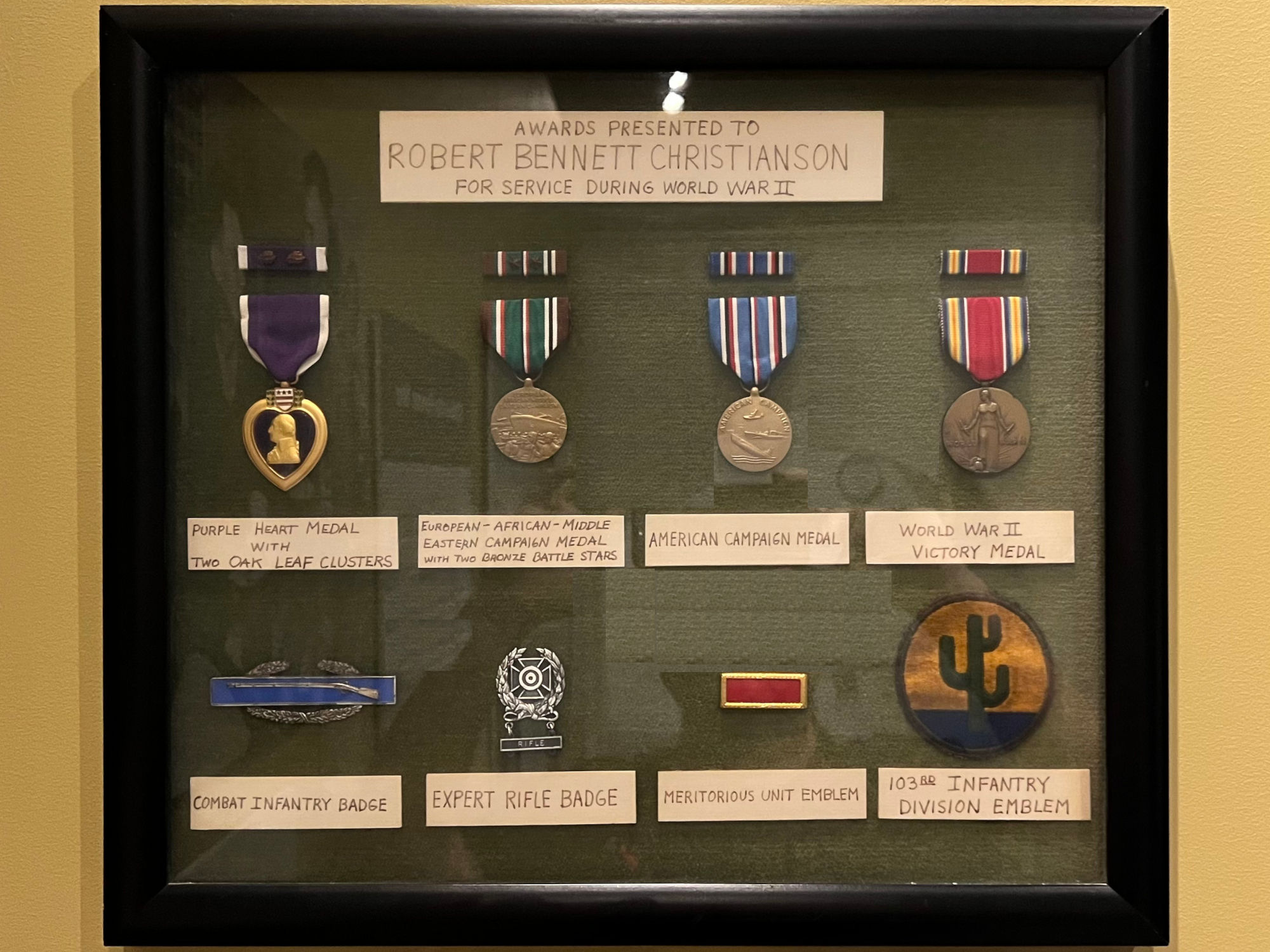
Service Medals
Private First Class Robert Christianson received a Purple Heart for the injuries he suffered as a POW.
Awards Presented to Robert Bennett Christianson for Service During World War II
- Purple Heart Medal with Two Oak Leaf Clusters
- European - African - Middle Eastern Campaign Medal with two Bronze Battle Stars
- American Campaign Medal
- World War II Victory Medal
- Combat Infantry Badge
- Expert Rifle Badge
- Meritorious Unit Emblem
- 103rd Infantry Division Emblem
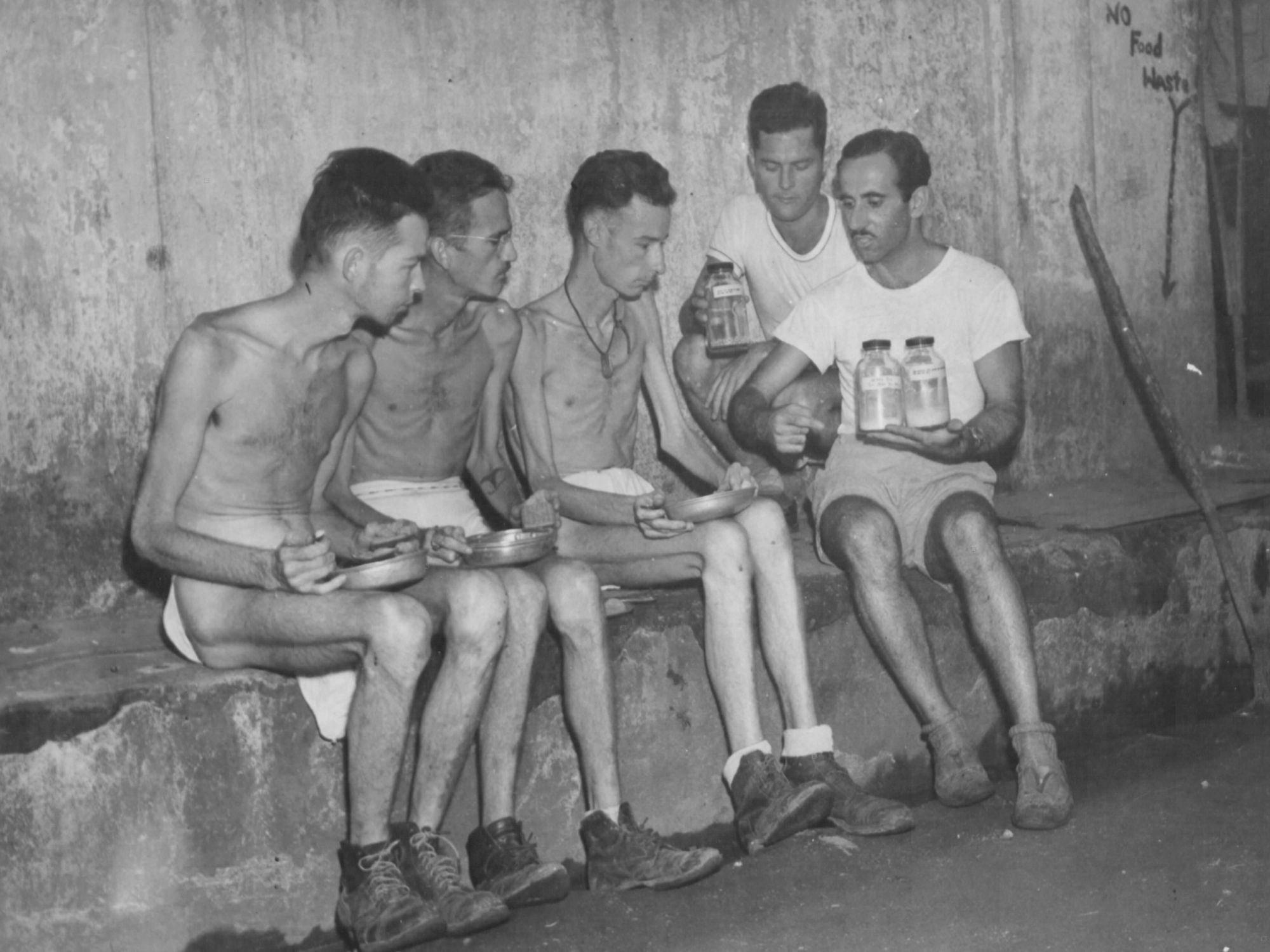
Three Liberated POWs
Old Bilibid Prison, Minaila, Philippine Islands
During World War II, a normal diet for an American soldier averaged 3,500 calories a day. American POWs held by the Japanese at Bilibid Prison in the Philippines, were provided 600 calories daily.
Whereas a normal diet for one man averages 3500 calories a day, the Japanese allowed only 600 or less a day to veterans of Corregidor and Bataan held prisoner at Bilibid Prison, Manila, Philippine Islands. Shown here enjoying a square meal after their liberation by U.S. tank destroyer units are:
- Private First Class Edward B. Claypool, Potosi, Missouri, who lost 48 lbs.
- Sergeant David W. Brumfield, Hope, Arkansas, who lost 51 lbs.
- Private First Class Fred Dunn, Columbus, Ohio, who lost 53 lbs.
- Pharmacist's Mate Thomas F. Brannon, Jr., Columbus, Georgia
- Captain Fred G. Nasr, Omaha, Nebraska
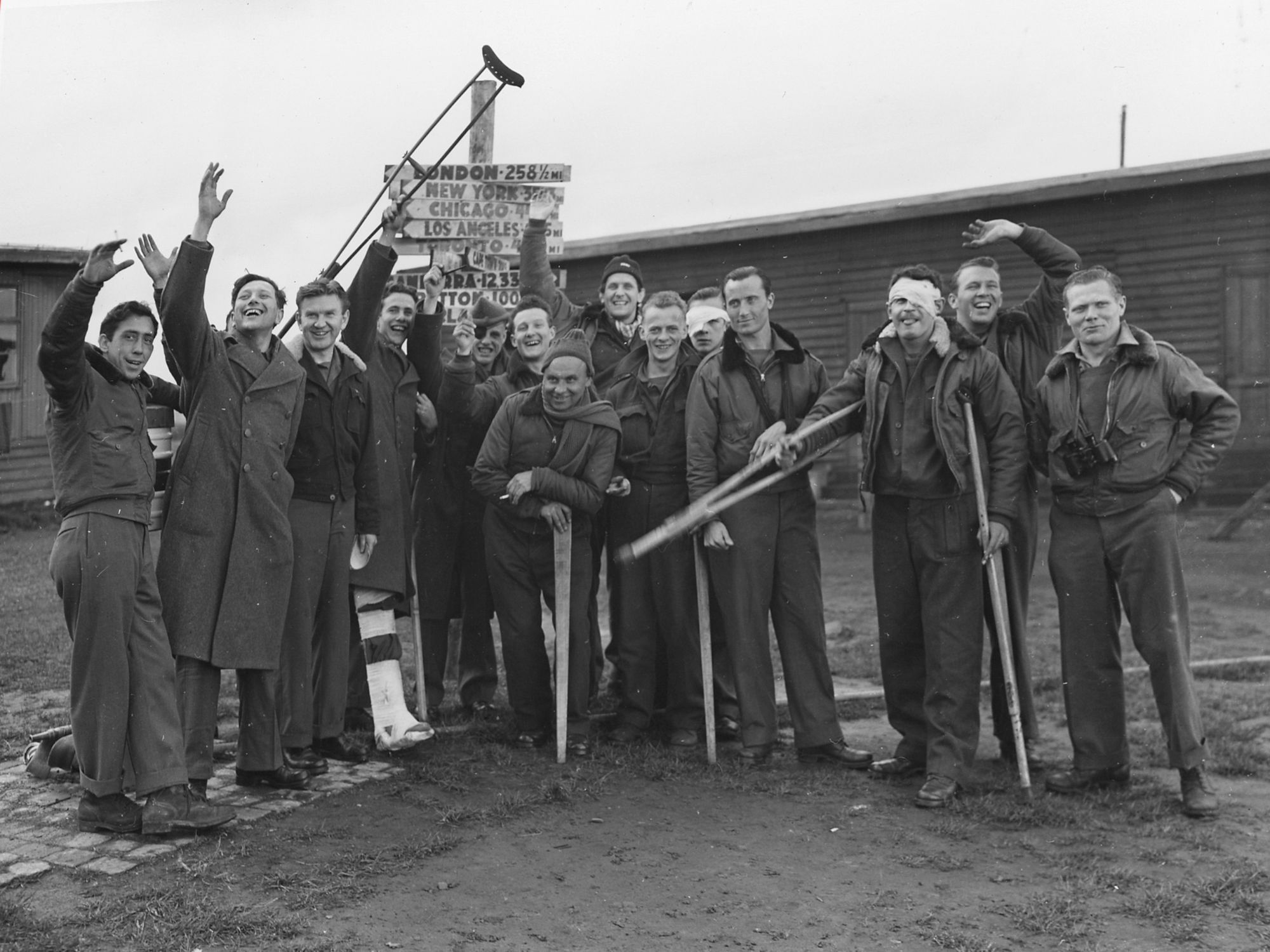
Freed Allied Soldiers
Camp Dulag-Luft near Wetzlar, Germany.
A group of World War II POWs held by the German military pose near a small sign that prisoners erected at Camp Dulag-Luft near Wetzlar, Germany.
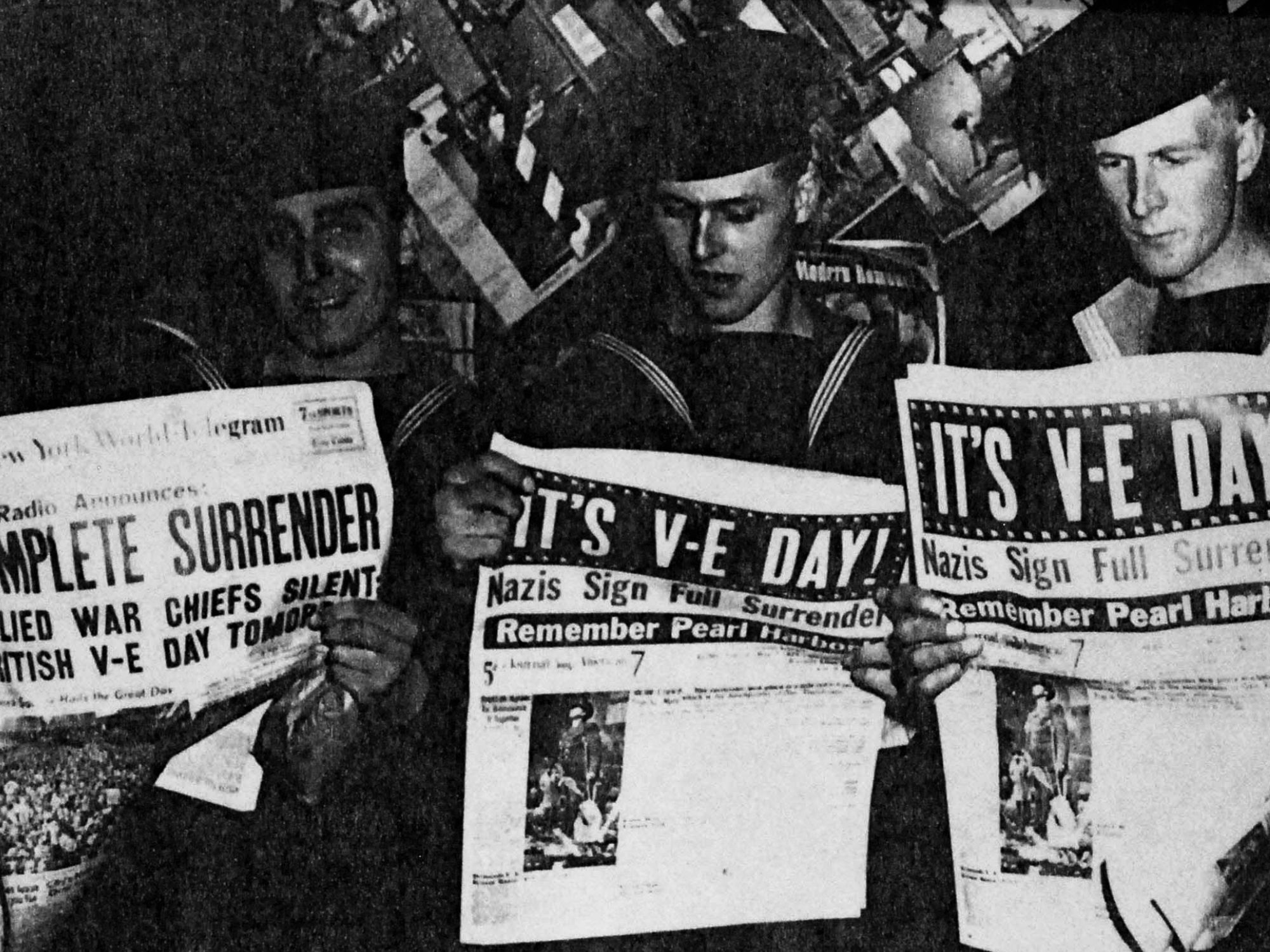
V-E Day
End of World War II in Europe
Sailors learn of the unconditional surrender of Nazi Germany. Victory in Europe Day: Fri, May 8, 2026
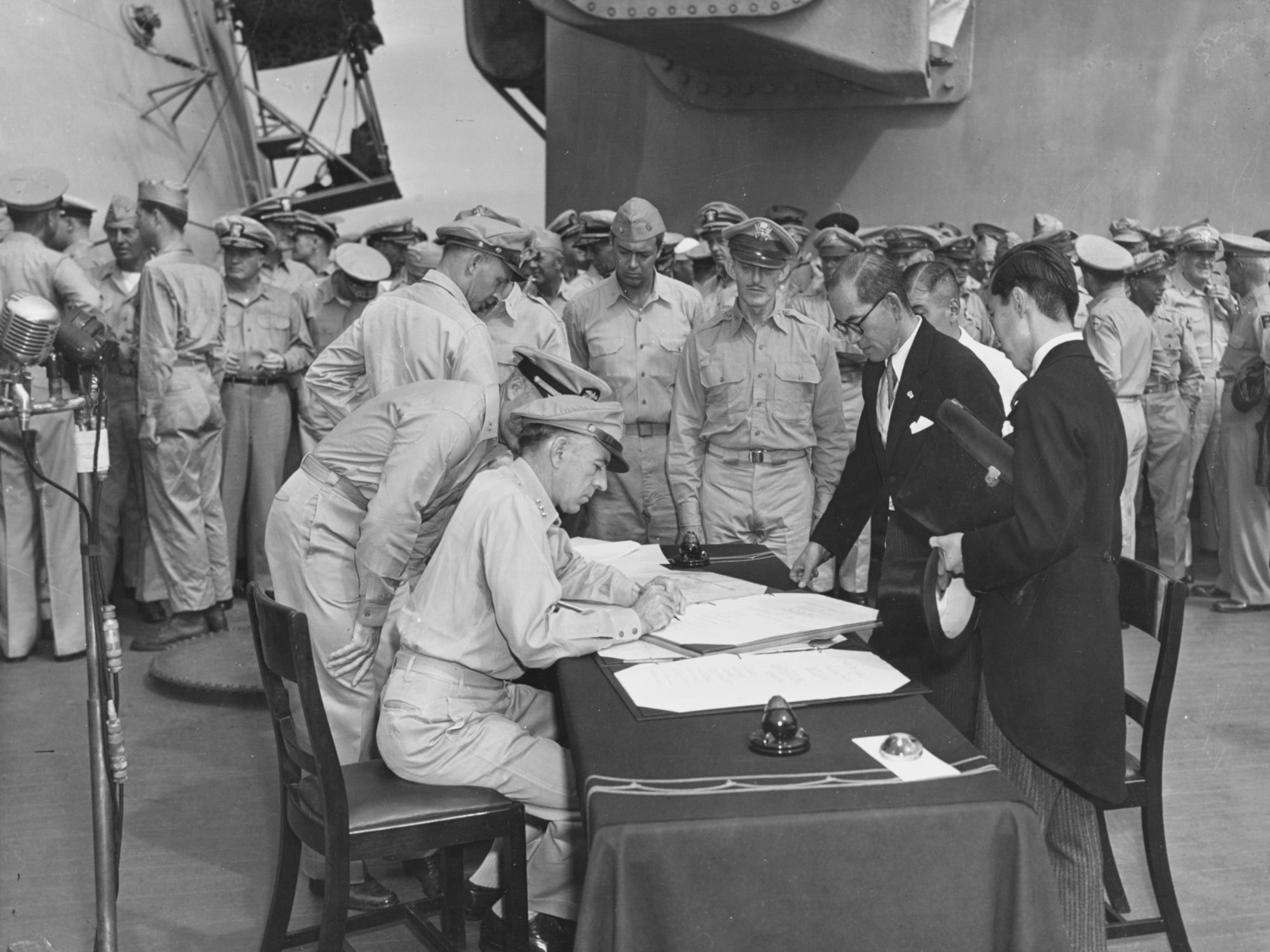
Instrument of Surrender
End of World War II in the Pacific
U.S. Army Lieutenant Gen. Richard Sutherland finalizing the instrument of surrender, bringing an end to World War II. The signing took place aboard the battleship USS Missouri in Tokyo Bay on September 2, 1945.
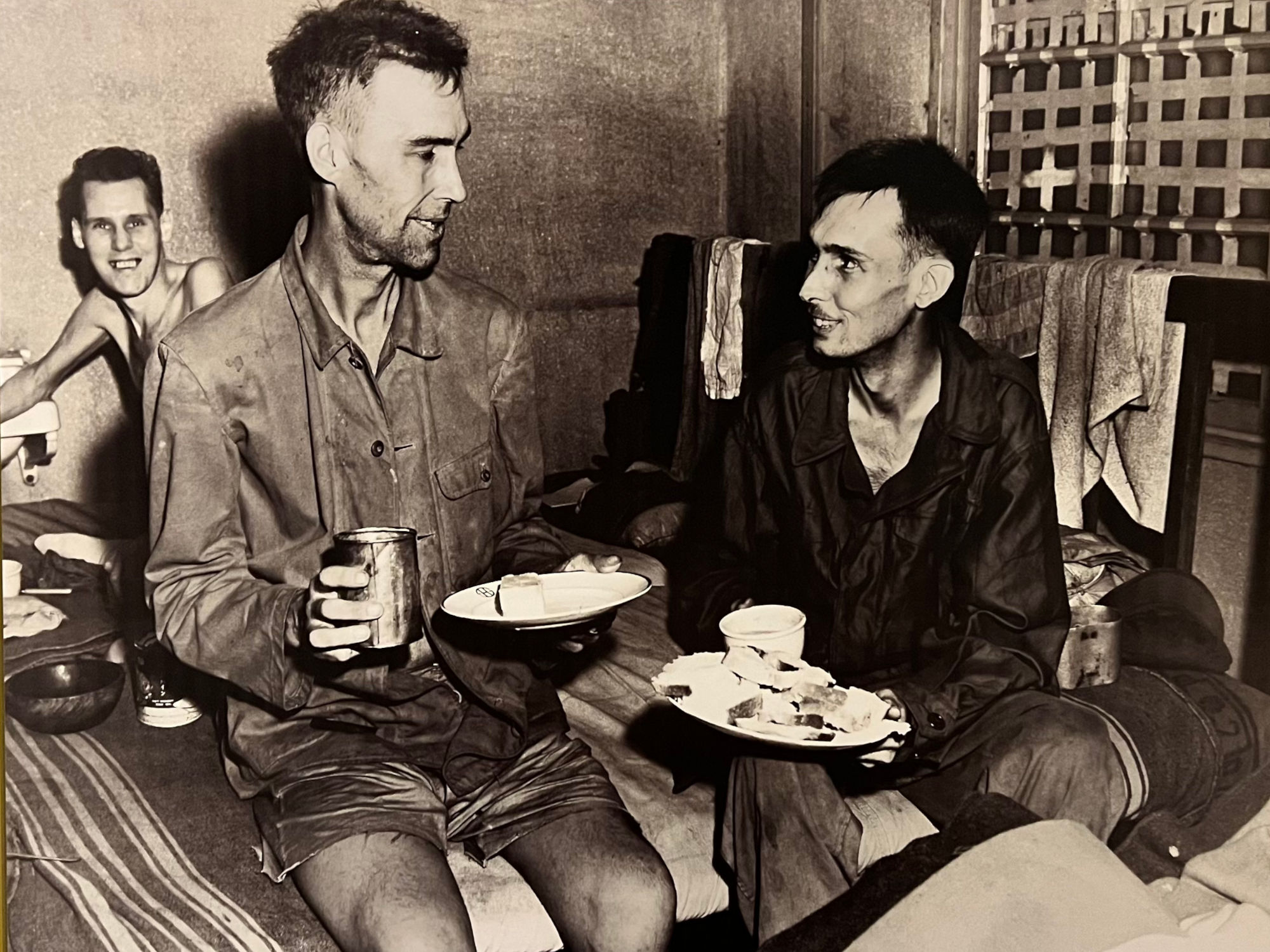
Liberated POWs
Taihoku, Formosa (Taipei, Taiwan)
- American Marine Corporal Jimmie Murphy
- Army Private First Class Wilbur Hansen
A Brief History of Vietnam
China expanded south into the area now known as Vietnam, beginning 1,000 years of Chinese rule. In the year 938 CE, Vietnam threw off its foreign rulers. For the next 900 years, Vietnam was ruled by a succession of imperial dynasties.
Led by Emperor Napoleon III, France sought to expand its empire into Southeast Asia in the 19th century. After a series of military conflicts, Vietnam was now part of what became known as French Indochina.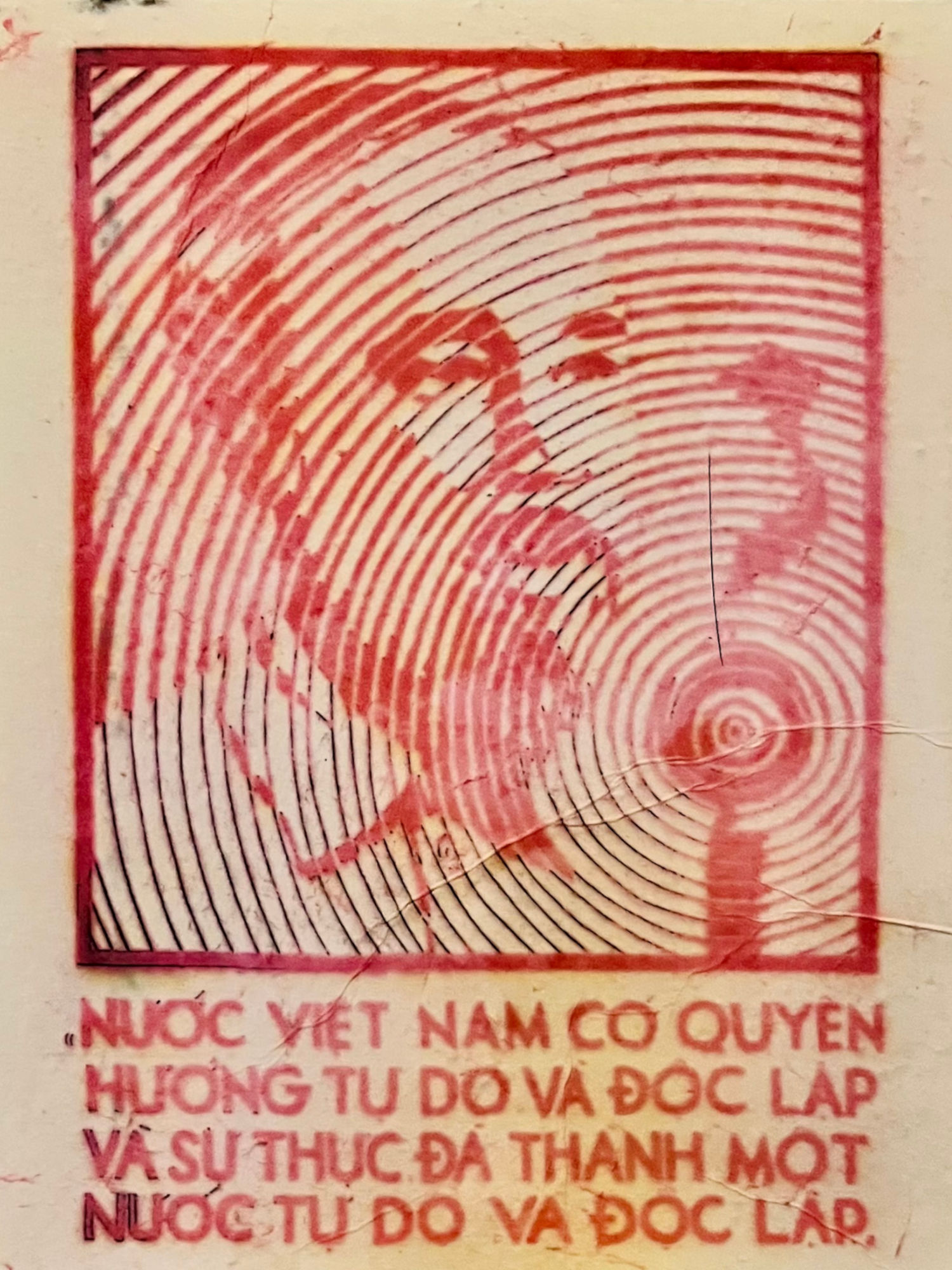
Ho Chi Minh was a charismatic Vietnamese communist nationalist. He grew tired of a century of oppressive French rule. Following the end of World War II, he declared Vietnam's independence on September 2, 1945.
Before a huge crowd, Ho began his speech in Hanoi with these words, taken from America's Declaration of Independence.
All men are created equal. They are endowed by their Creator with certain inalienable rights, among them are Life, Liberty, and the pursuit of Happiness.
France did not accept the loss of Vietnam from its colonial empire. For the next nine years, the French sought to reassert control over Vietnam in the First Indochina War.
Why Vietnam?
The Truman Doctrine
America's involvement in the Vietnam War can only be understood in the context of the Cold War. President Truman articulated in a speech to Congress what became known as the Truman Doctrine.
RELATED: [https://www.eatlife.net/cold-war.php]
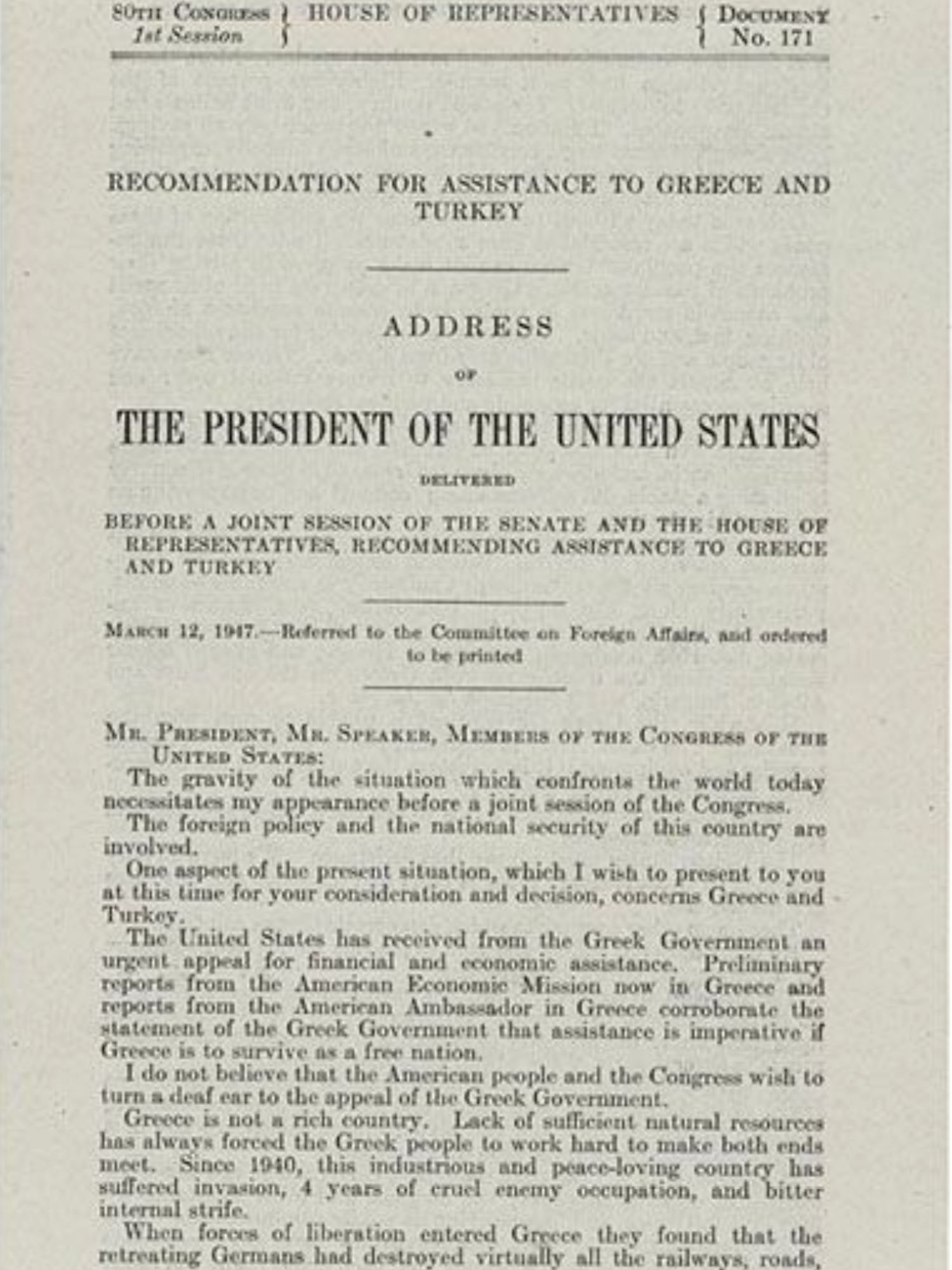 At the heart of the Truman Doctrine was the policy of containment. Under this policy, the United States would resist the expansion of communism and other forms of totalitarianism beyond where it already existed. American foreign policy would be guided by containment for the next 45 years.
At the heart of the Truman Doctrine was the policy of containment. Under this policy, the United States would resist the expansion of communism and other forms of totalitarianism beyond where it already existed. American foreign policy would be guided by containment for the next 45 years.
I believe that it must be the policy of the United States to support free peoples who are resisting attempted subjugation by armed minorities or by outside pressures.
- President Harry Truman, March 12, 1947
The invasion of South Korea in 1950 by North Korea (supported by the Soviet Union and the People's Republic of China was the first major test of Truman's policy. Over the next three years, American troops fought for the survival of South Korea. By the time the fighting ended in a ceasefire, more than 36,000 Americans had died.
The Geneva Conventions
International standards for the treatment of POWs were adopted at a meeting in Geneva, Switzerland. Known as the Geneva Conventions, these rules protect prisoners from mistreatment at the hands of their captors.
The provisions of the Geneva Conventions include:
- POWs are only required to give their name, rank, birthdate, and serial number to their captors.
- POWs must be humanely treated at all times.
- Cruel treatment and torture are prohibited.
- Humiliating and degrading treatment is prohibited.
- POWs must be protected against acts of violence and intimidation.
- POWs must be protected from insults and public curiosity.
- Reprisals against POWs are prohibited.
Both the United States and North Vietnam agreed to abide by the Geneva Conventions.
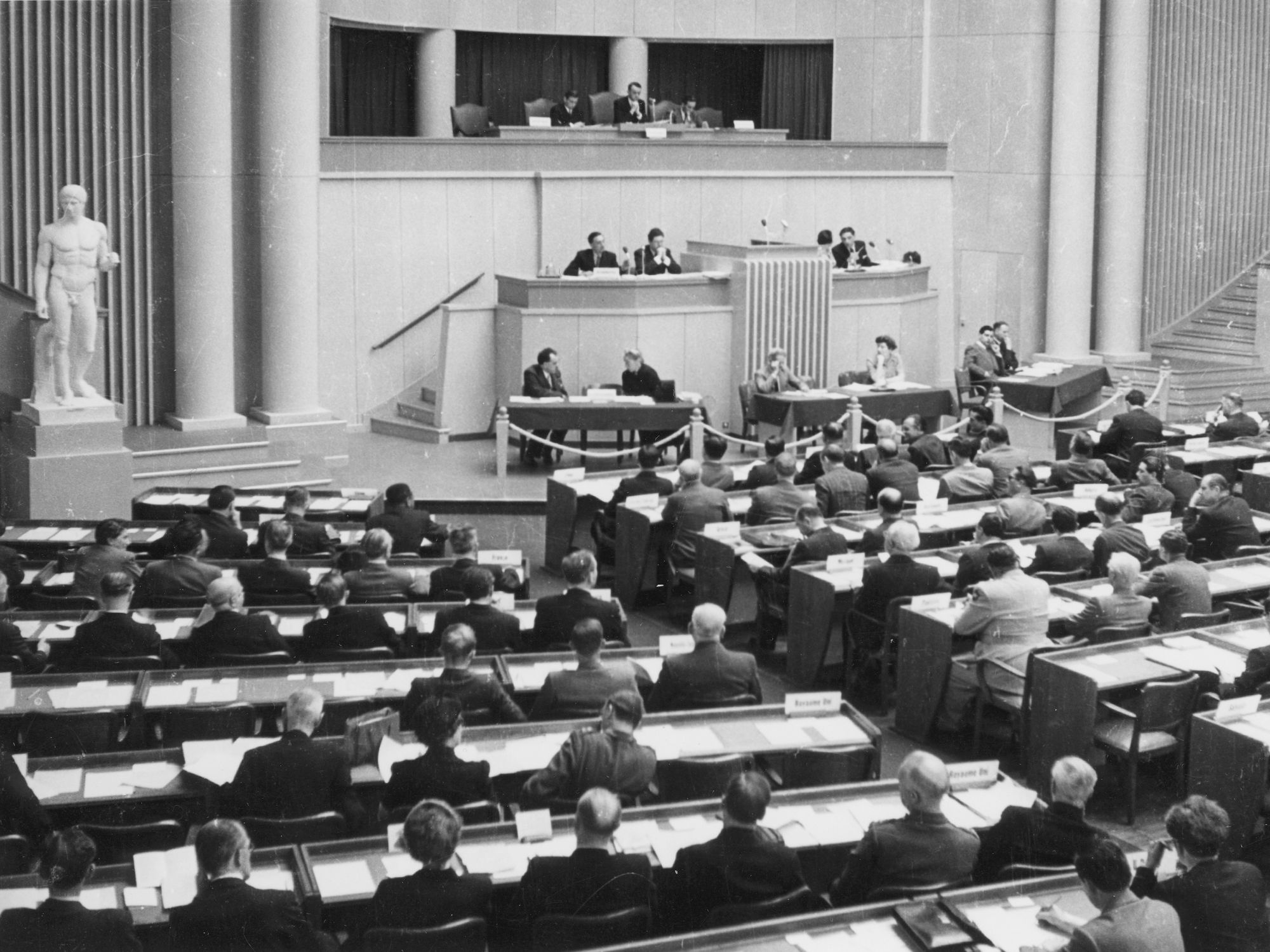
POW Rules
Geneva, Switzerland
The Geneva Conventions of 1949 established rules for warfare between modern states. The conventions set international norms for the conduct of warfare, including the treatment of POWs.
POWs in the Korean War
In 1945, following Japan's surrender in World War II, the formerly occupied Korean Peninsula was divided along the 38th parallel. Three years later, two new nations were created. The communist Democratic People's Republic of Korea ruled in the north. The anti-communist Republic of Korea governed the south.
On June 25, 1950, North Korean troops crossed the 38th parallel, invading South Korea. They sought to create a unified Korea under a communist government. Two days later, President Truman ordered U.S. air and naval forces to resist the communist aggression in Korea. This was the first major test of the Truman Doctrine of containing communism.
By the time fighting ended 37 months later, nearly 1.8 million Americans would serve in Korea; 33,739 would lose their lives.
More than 7,100 Americans were held in horrific conditions as prisoners of war, in violation of the Geneva Conventions. More than 2,700 died in captivity. North Korea subjected the POWs to cruel indoctrination techniques. American servicemen had not been trained in resisting such treatment or maintaining solidarity with their fellow POWs.
Two years after the conclusion of the fighting (August 1955), President Eisenhower issued a Code of Conduct for future POWs. It would prove to be an invaluable tool for maintaining the morale and unity in Vietnam.
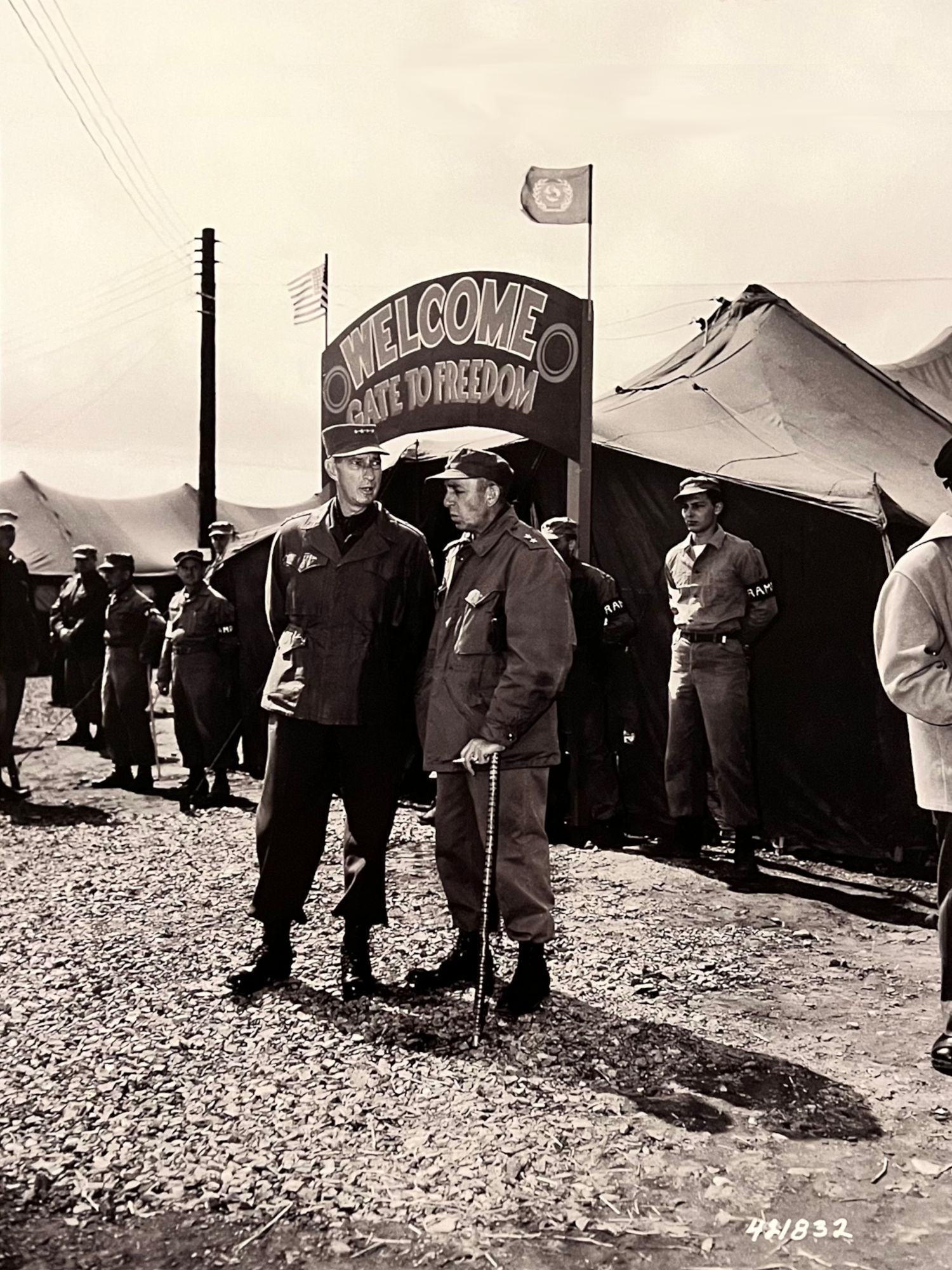
Operation Little Switch
45th Mobile Army Surgical Hospital, South Korea
The flags of the United Nations and the United States fly over the "Gates to Freedom," erected at the border into friendly territory for freed POWs.
- Waiting for the arrival of the first group of United Nations prisoners of war to be repatriated from the Korean War.
- Army General Mark W. Clark
- Army Major General Thomas W. Herren
Communist Expansion:
Falling Like Dominos?With the French military on the verge of defeat at Dien Bien Phu, nearly half of the questions for President Eisenhower during an April 7, 1954 news conference concerned Indochina. A reporter asked the President to comment" ...on the strategic importance of Indochina to the free world."
President Eisenhower's answer came to be known as the Domino Theory - a belief that if one country fell to communist aggression, its neighbors would soon follow.
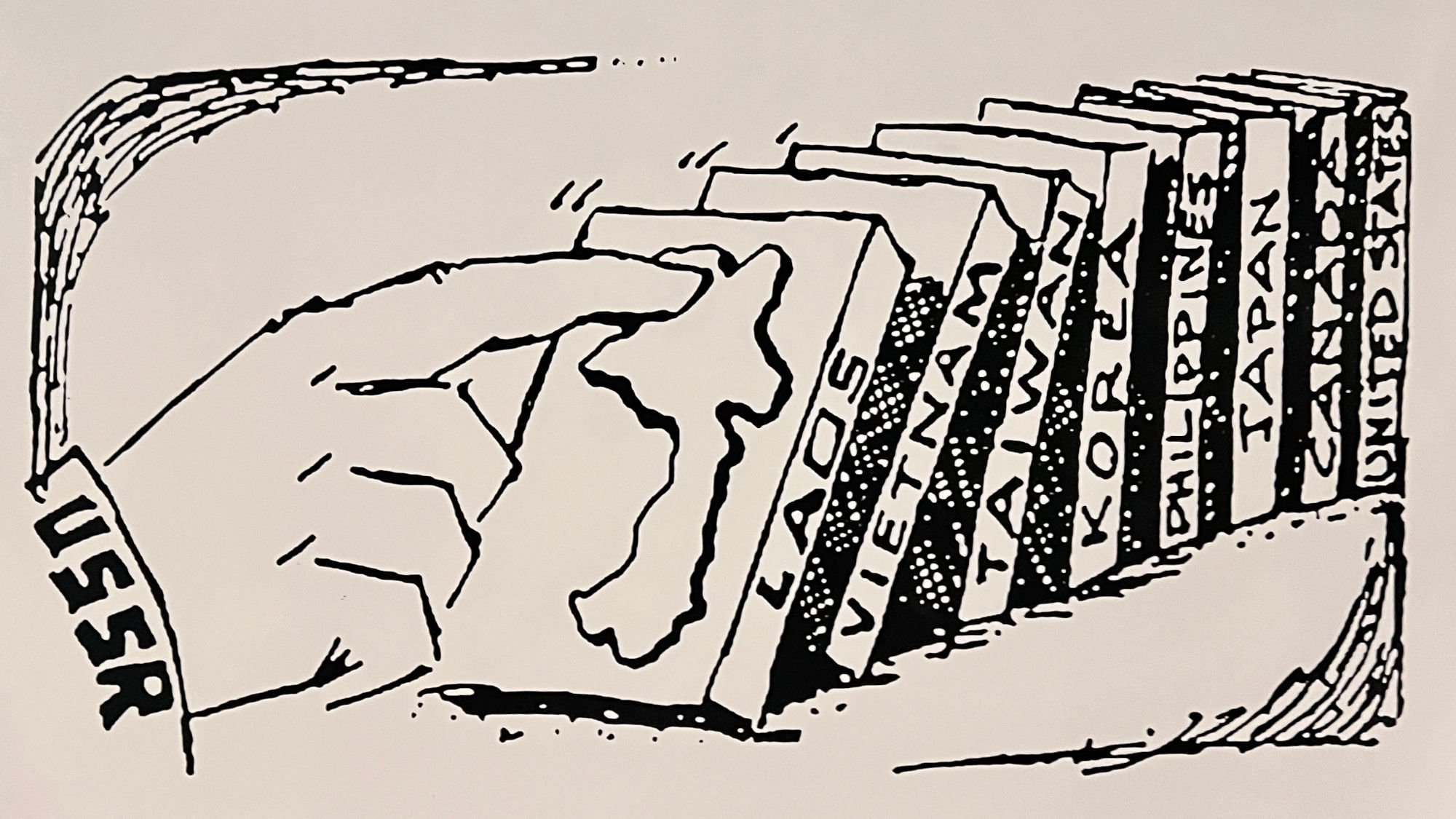
You have a row of dominoes set up, you knock over the first one, and what will happen to the last one is the certainty that it will go over very quickly. So you could have a beginning of a disintegration that would have the most profound influences.
But when we come to the possible sequence of events, the loss of Indochina, of Burma, of Thailand, of the Peninsula, and Indonesia following... now you are talking really about millions and millions and millions of people.
Then with respect to more people passing under this domination, Asia, after all, has already lost some 450 million of its peoples to the Communist dictatorship, and we simply can't afford greater losses
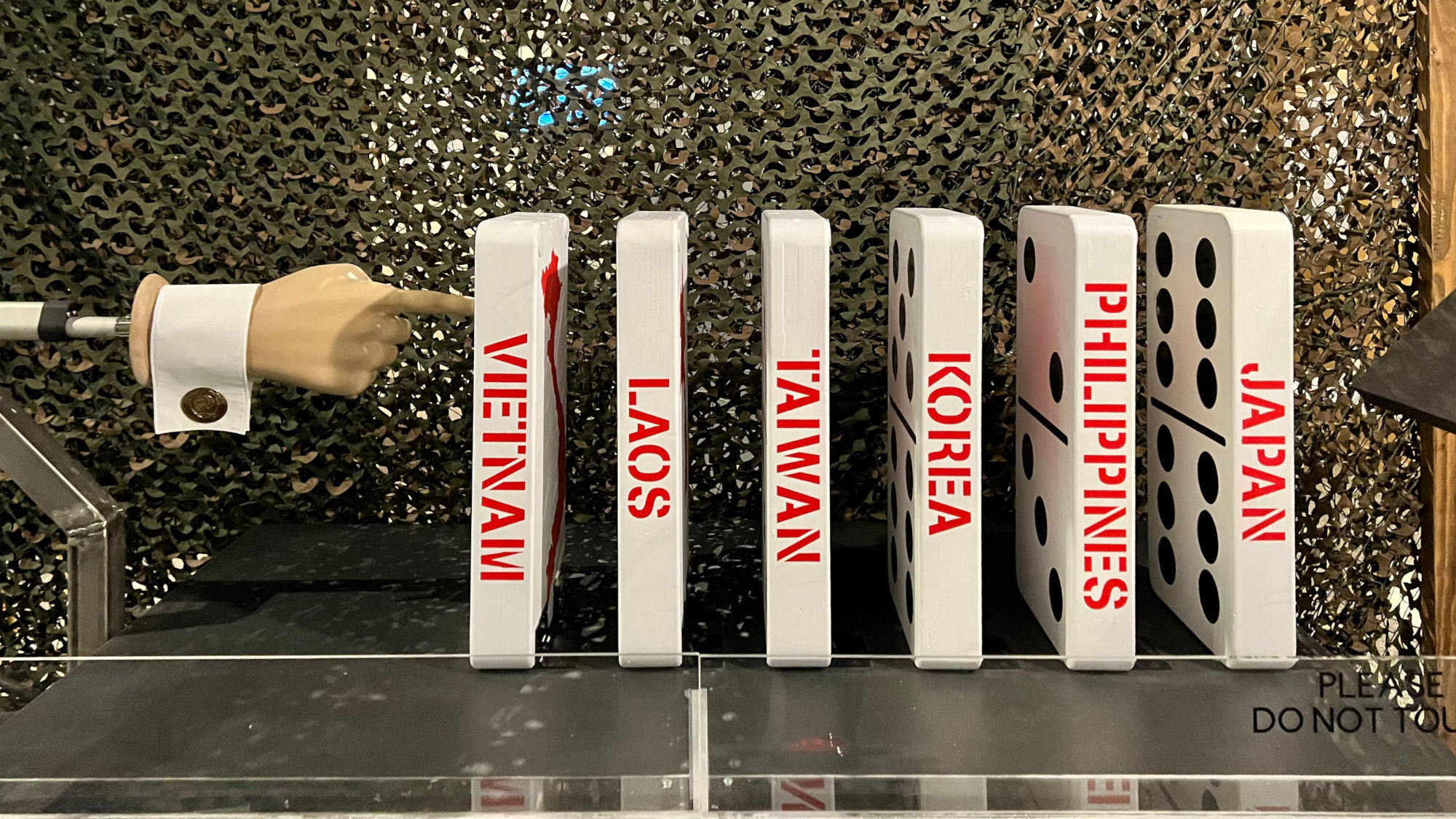
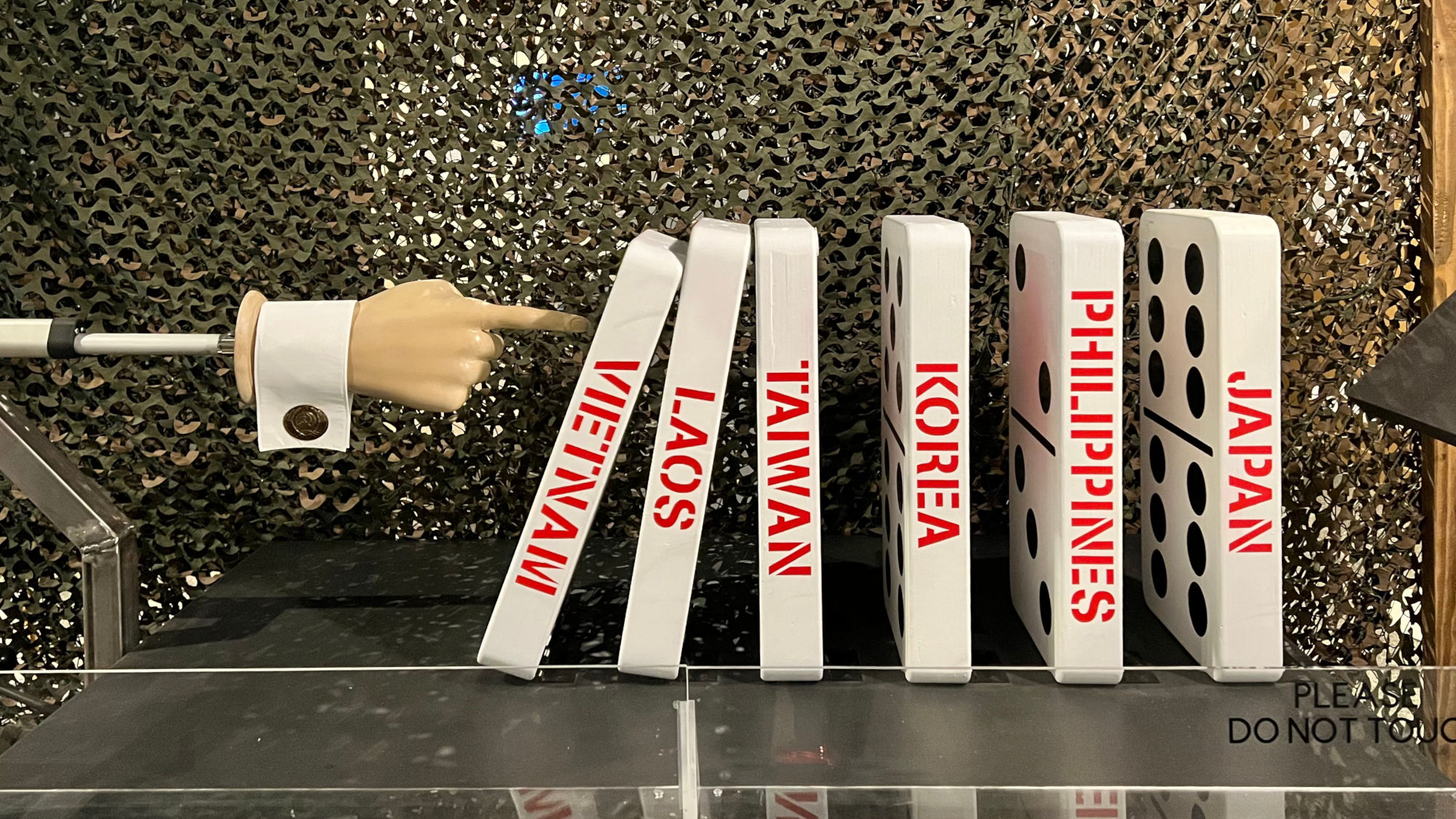
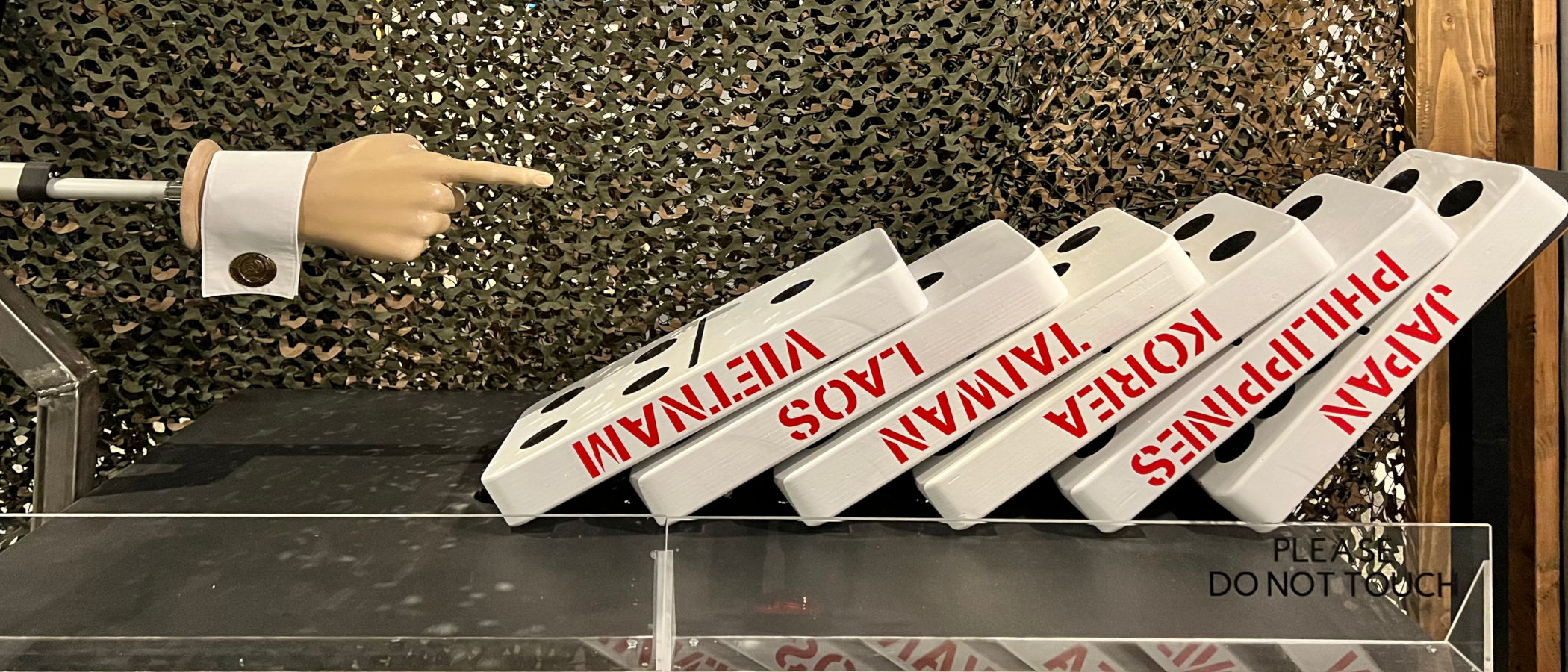
Dien Bien Phu
May 1954
The French army was encamped at its heavily fortified base in Dien Bien Phu. They suffered a humiliating defeat there by Ho Chi Minh's forces. After its defeat, the French retreated from Vietnam.
In their absence, the United States would become deeply involved in the next chapter of Vietnam's history.
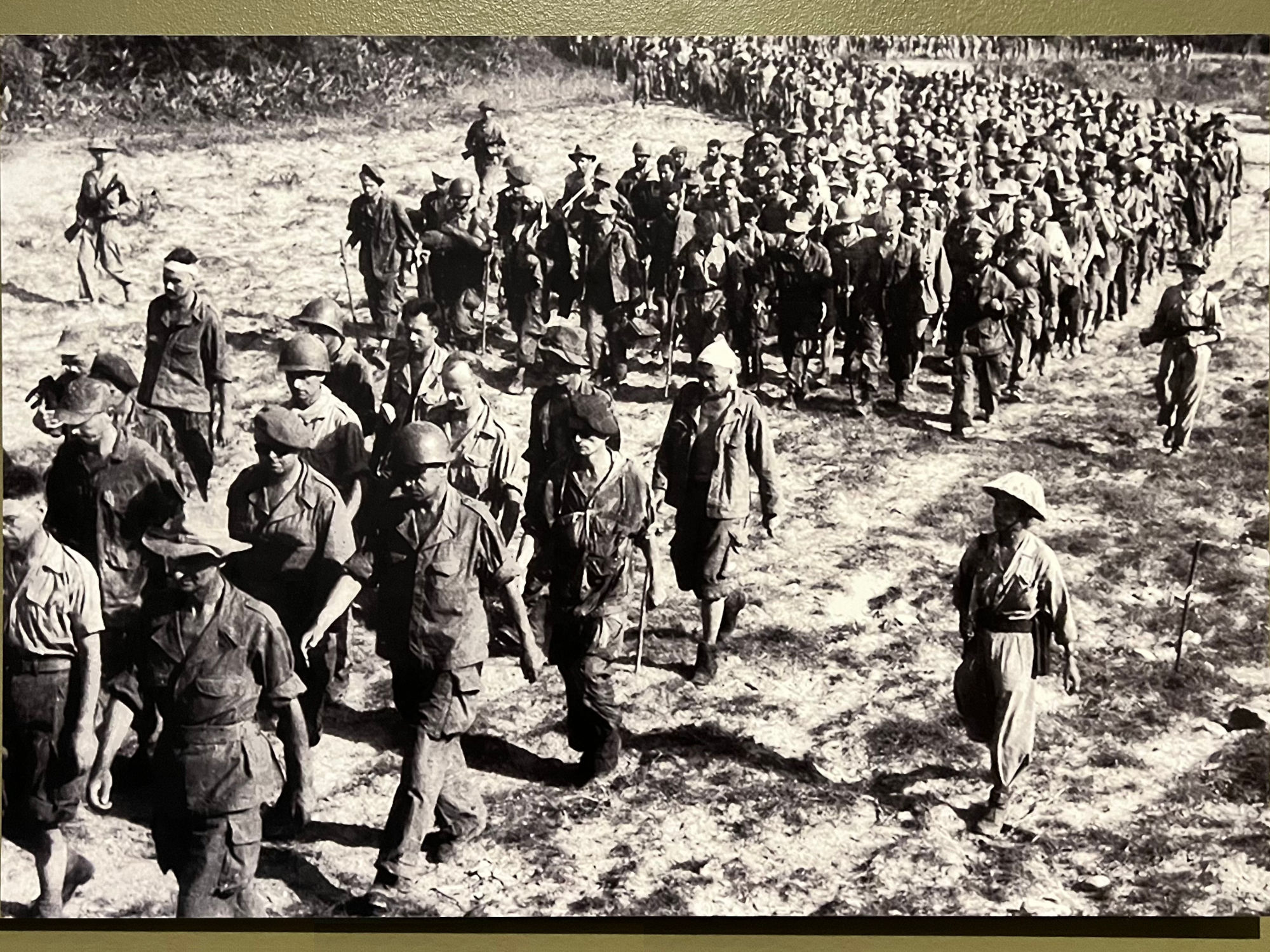
Battle of Dien Bien Phu
Vietnamese Independence
Hundreds of captured French troops are marched to a holding area under the watchful eye of the victorious Viet Minh. The capture of so many troops forced the French to accept Vietnamese independence.
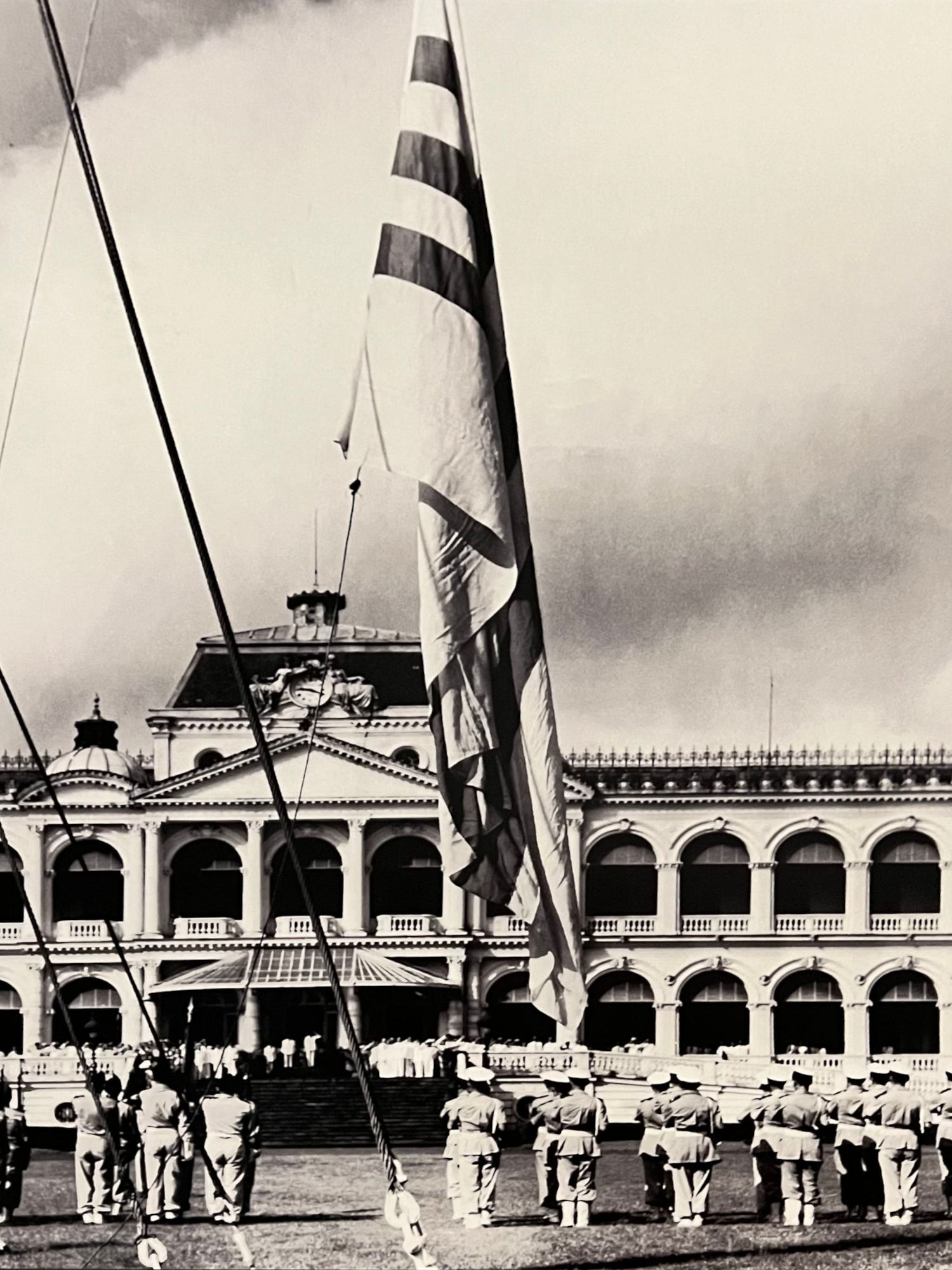
French Exit
Republic of Vietnam renamed the Norodom Palace to Independence Palace
The Vietnamese flag is raised in South Vietnam's capital city, Saigon. This flag raising was a symbolic ceremony during the French exit, representing the new country's independence.
The French Leave Behind a Brief, Uneasy Peace
The defeat of the French at Dien Bien Phu essentially ended French colonial rule in Vietnam. Their withdrawal left an unstable political situation in Vietnam.
Seeking to address this instability, the French and Vietnamese, along with diplomats from China and the United States, met in Geneva, Switzerland.
France and the nationalist organization Viet Minh, agreed to temporarily divide Vietnam along the 17th parallel. This created a demilitarized zone between the north and south. Communist forces would be in control of North Vietnam. French forces would remain in South Vietnam.
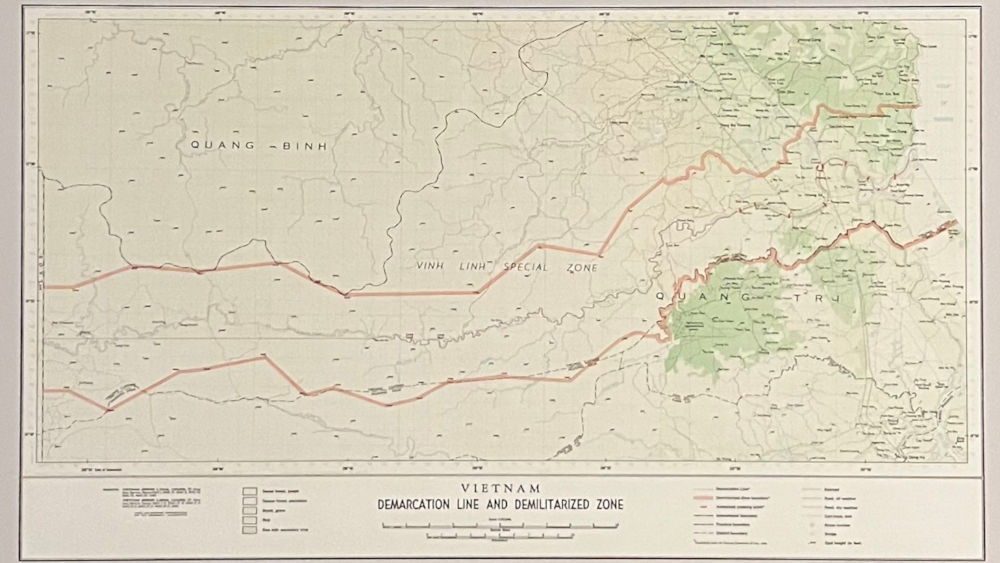
Demilitarized Zone Map
An official U.S. government map showing the 17th parallel demilitarized zone
North and South Vietnam was divided along the 17th parallel. This created a demilitarized zone between the two countries.
- North Vietnam, under communist control, sought to unify Vietnam by force under a communist government.
- The United States supported South Vietnam to stop the spread of communism.
This uneasy peace did not last long. In the north, Ho Chi Minh established a communist government. In the south, the last emperor of Vietnam, Bao Dai and his replacement, Ngo Dihn Diem, both sought closer ties with the West.
The United States supported the new, non-communist government to counter the communist north. Elections were scheduled to occur in 1956 to choose a government for a unified Vietnam. The elections never took place. The die was cast. Vietnam - North and South - became a battlefield in the Cold War.
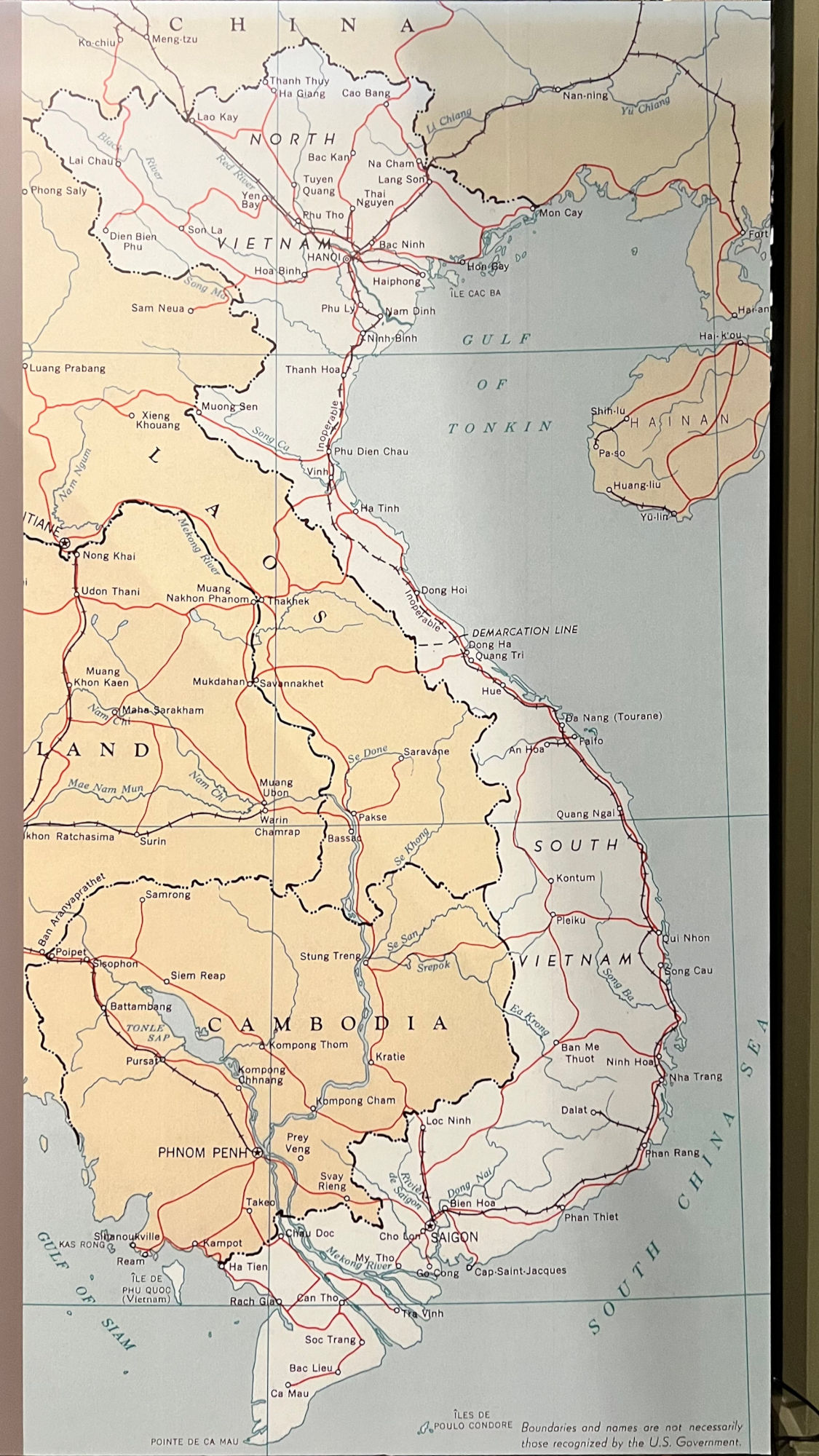
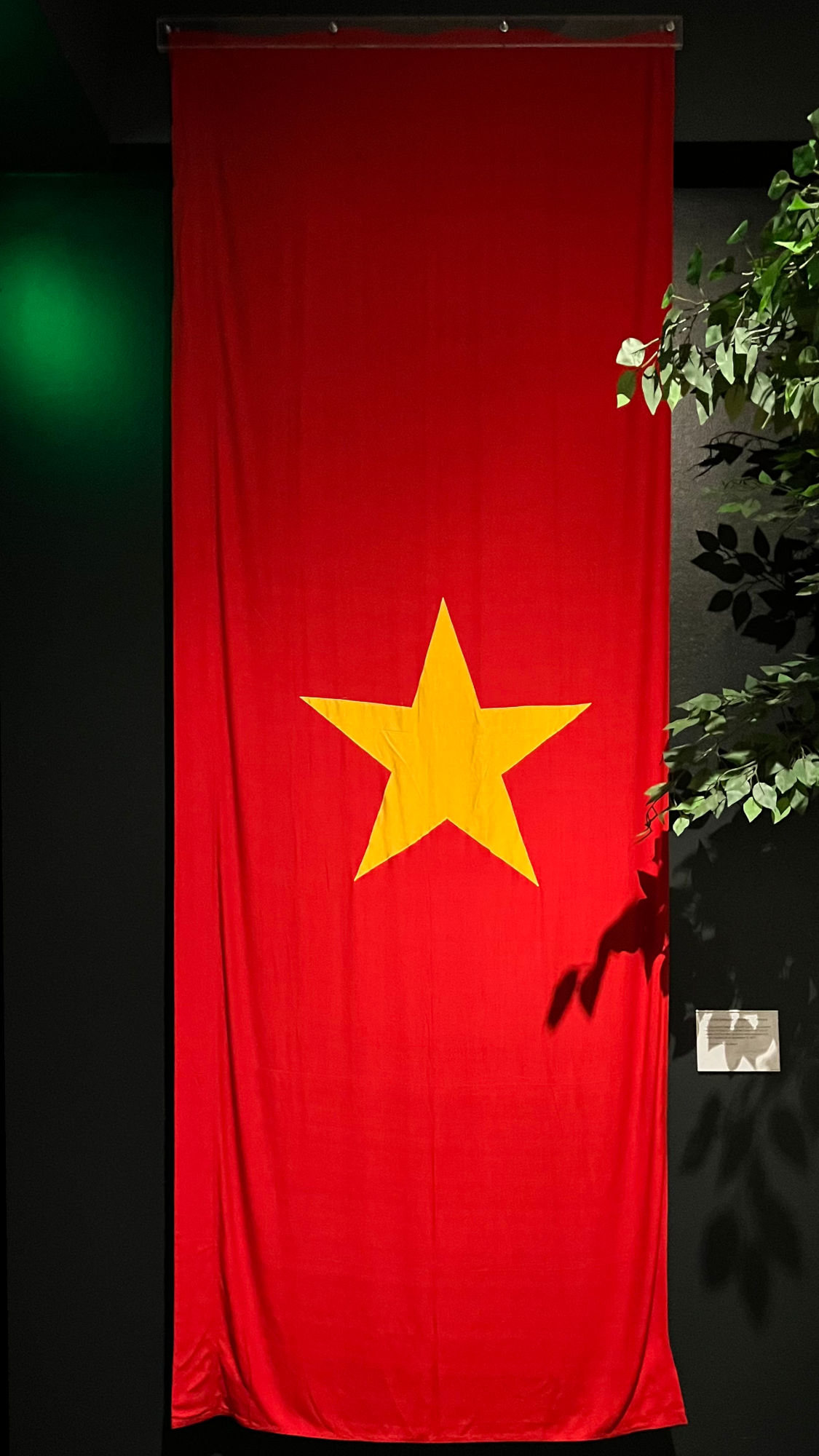
Flag of North Vietnam
Democratic Republic of Vietnam
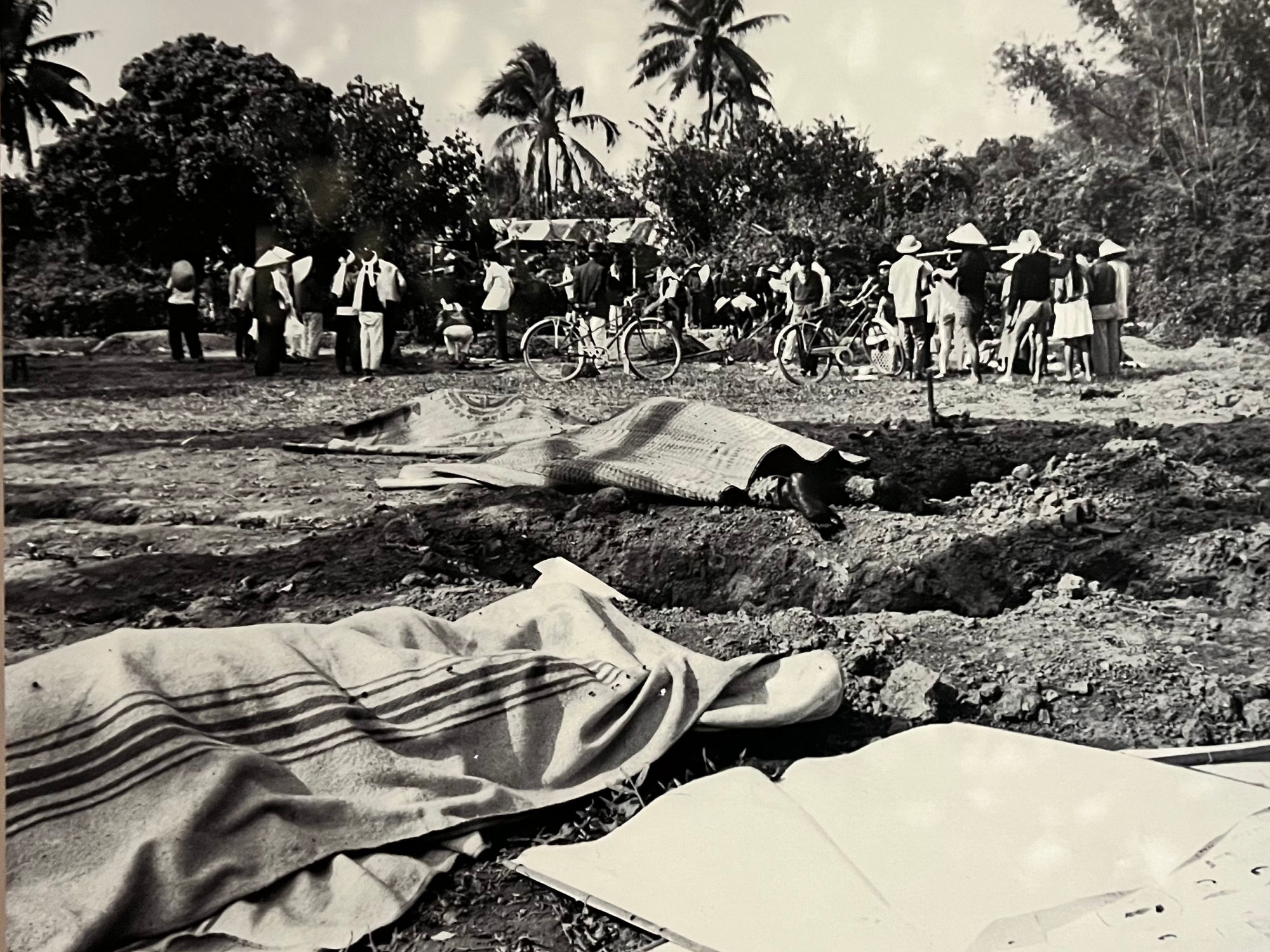
North vs. South - A Civil War?
Communist forces left this village destroyed and civilians dead
One of the fundamental questions about America's involvement in Vietnam was: What kind of war was it? Was it a conflict between two separate nations with opposing political ideologies? Was it a civil war between two factions inside one country?
The United States understood Vietnam as a struggle between communism and anti-communism. It was a proxy war in the greater contest between the United States and Soviet Union to assert global influence.
The North Vietnamese viewed it as a war of reunification. They sought to install a communist government across all of Vietnam. It saw foreign intervention on behalf of South Vietnam as meddling in the internal affairs of a unified Vietnam. Nevertheless, North Vietnam readily accepted substantial military support from the Soviet Union and the People's Republic of China.
This question has been debated for decades and will undoubtedly continue to be discussed.
The Code of Conduct:
How to Act as a POW
After the 1953 agreement that ended the fighting in Korea, it became clear that the Americans held as POWs by North Korea were unprepared for the ordeal they suffered. They were subjected to brutal physical and psychological treatment at the hands of their captors. Many were left with what today would be called Post-Traumatic Stress Disorder (PTSD).
President Eisenhower, the former General of the Army and Supreme Allied Commander of Europe during World War II, decided that every member of the armed forces required training and guidance on how to survive should they ever be taken as POWs.
On August 17, 1955, he issued Executive Order 10631. The order said:
CODE OF CONDUCT
For Members of the Armed Forces of the United States
- I am an American fighting man. I serve in the forces which guard my country and our way of life. I am prepared to give my life in their defense.
- I will never surrender of my own free will. If in command I will never surrender my men while they still have the means to resist.
- If I am captured I will continue to resist by all means available. I will make every effort to escape and aid others to escape. I will accept neither parole nor special favors from the enemy.
- If I become a prisoner of war, I will keep faith with my fellow prisoners. I will give no information or take part in any action which might be harmful to my comrades. If I am senior, I will take command. If not, I will obey the lawful orders of those appointed over me and will back them up in every way.
- When questioned, should I become a prisoner of war, I am bound to give only name, rank, service number, and date of birth. I will evade answering further questions to the utmost of my ability. I will make no oral or written statements disloyal to my country and its allies or harmful to their cause.
- I will never forget that I am an American fighting man, responsible for my actions, and dedicated to the principles which made my country free. I will trust in my God and in the United States of America
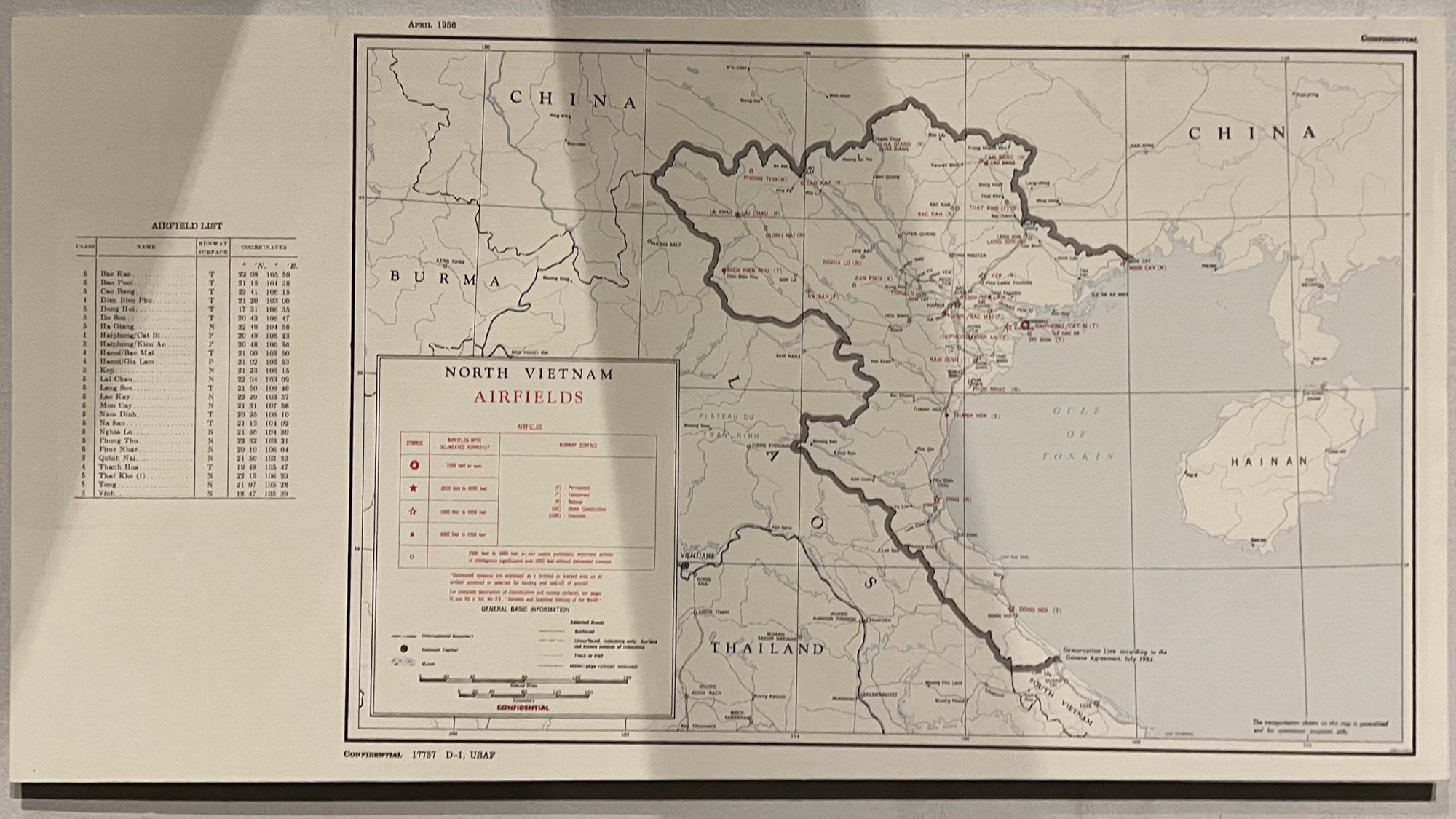
Airfields Map
North Vietnam
- Bac Kan
- Ban Puoi
- Cao Bang
- Dien Bien Phu
- Dong Hoi
- Do Son
- Ha Giang
- Haiphong/Cat Bi
- Haiphong/Kien An
- Hanoi/Bac Mai
- Hanoi/Gia Lam
- Kep
- Lai Chau
- Lang Son
- Lao Kay
- Mon Cay
- Nam Dinh
- Na San
- Nghia Lo
- Phong Tho
- Phuc Nhac
- Quinh Nai
- Thanh Hoa
- That Khe (1)
- Tong
- Vinh
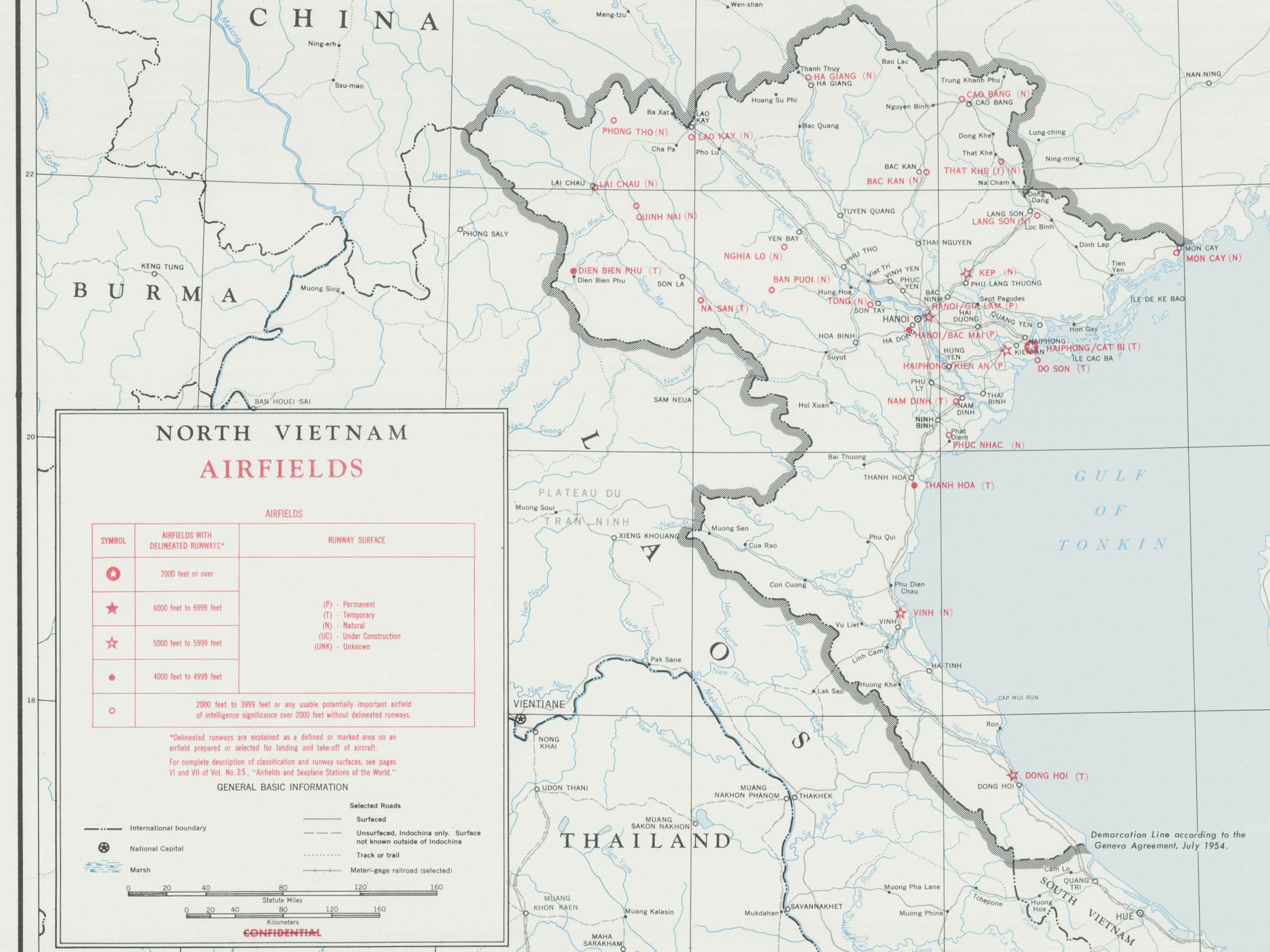
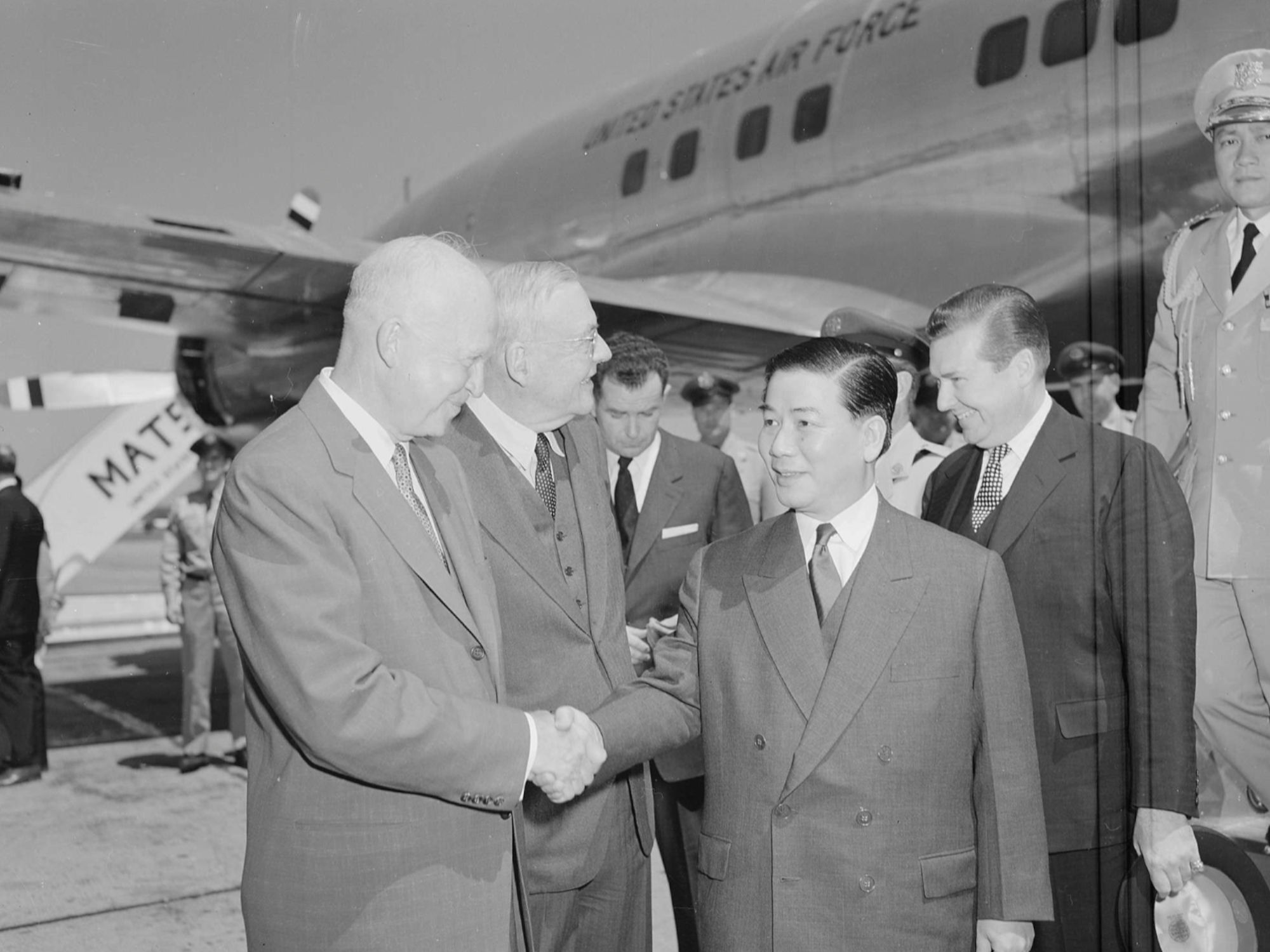
President Dwight Eisenhower
President Eisenhower and Secretary of State John Foster Dulles greet South Vientam's President Diem at Washington National Airport, May 8th, 1957
President Dwight Eisenhower offered American support to the president of South Vietnam, Ngo Dinh Diem. Under Eisenhower, the United States sent more than $2 billion in military aid. The number of American military advisors grew from 35 to about 1,000 by the time Eisenhower left office on January 20, 1961.
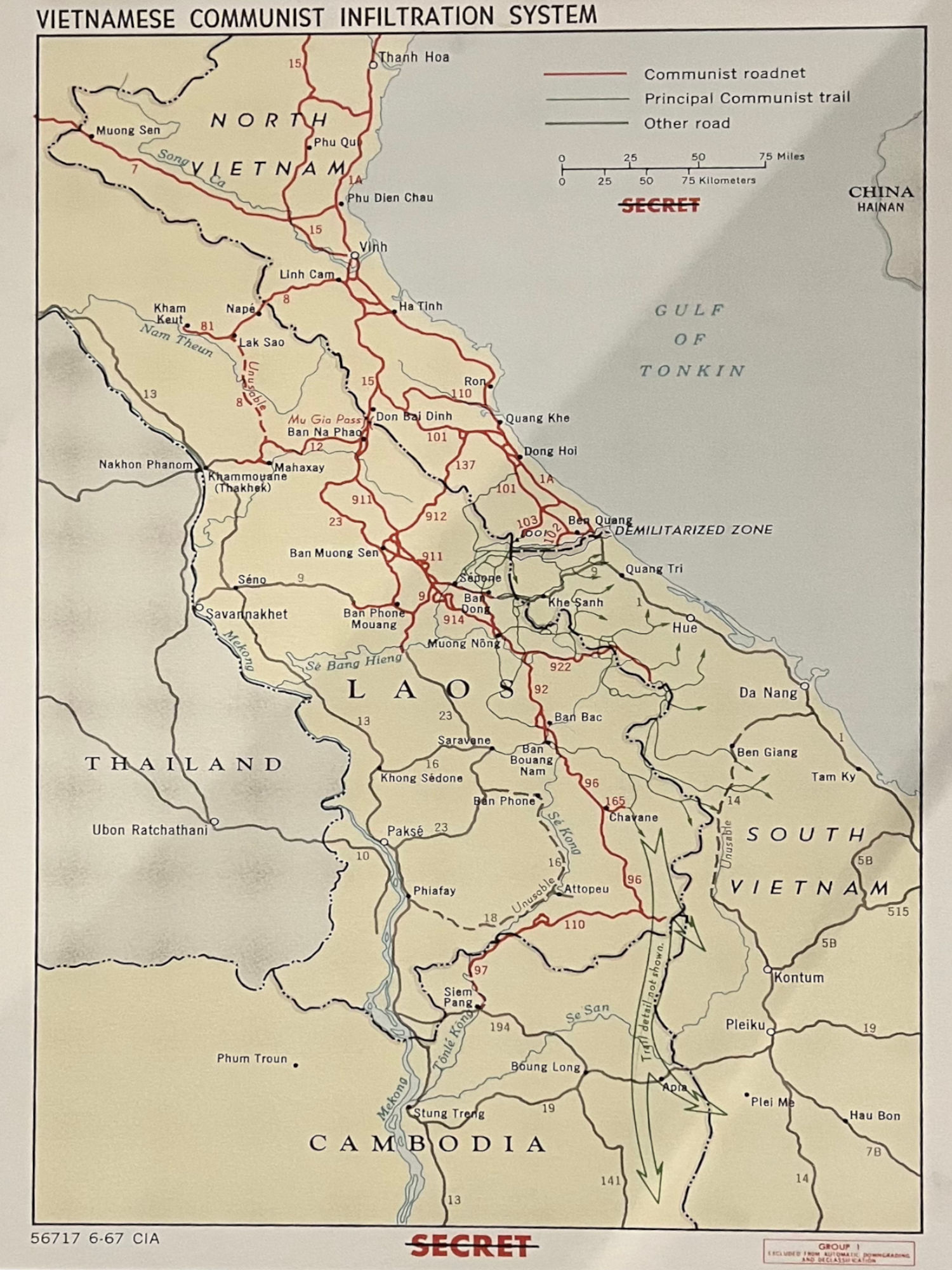
The Ho Chi Minh Trail
Vietnamese Communist Infiltration System
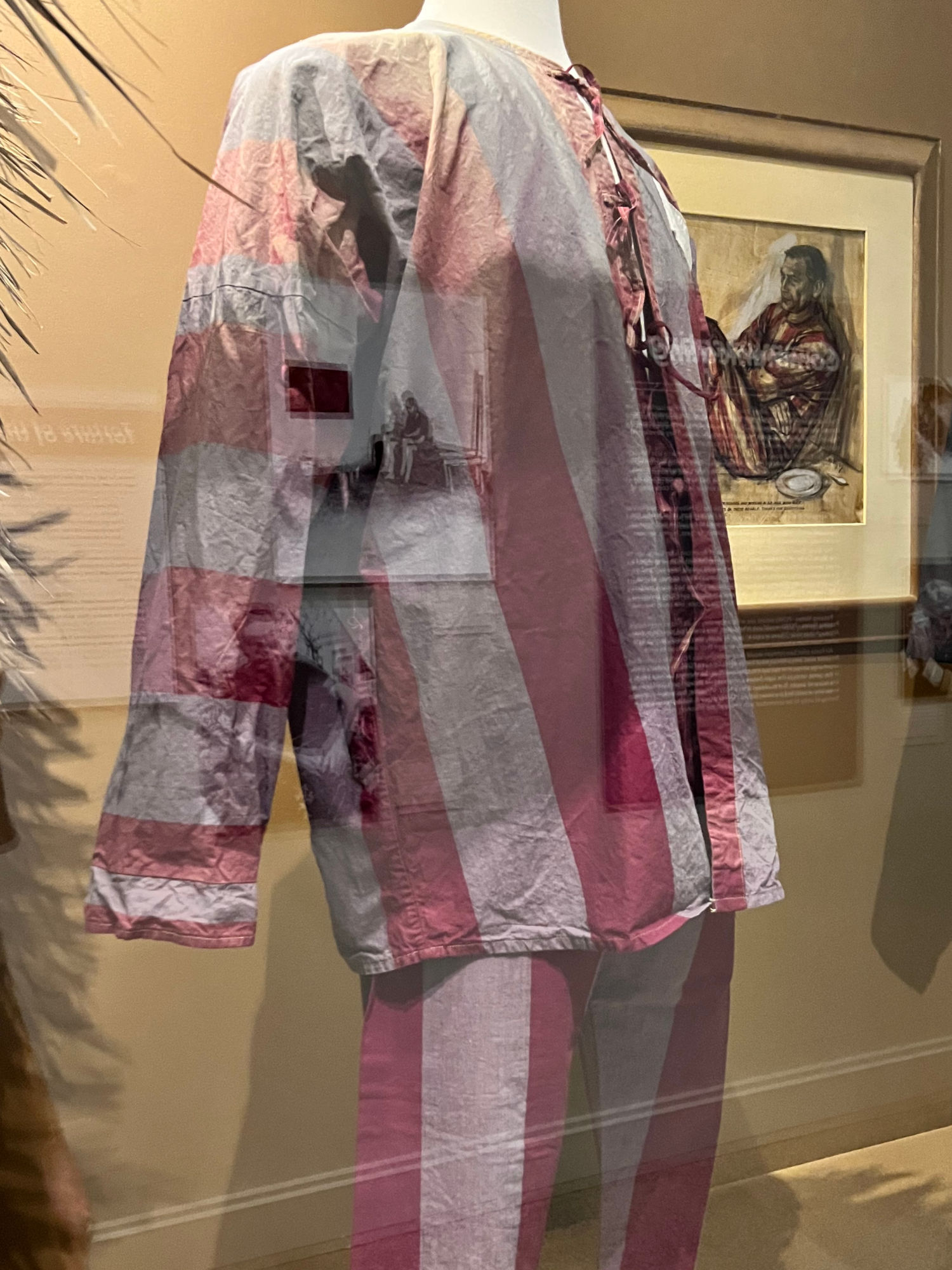
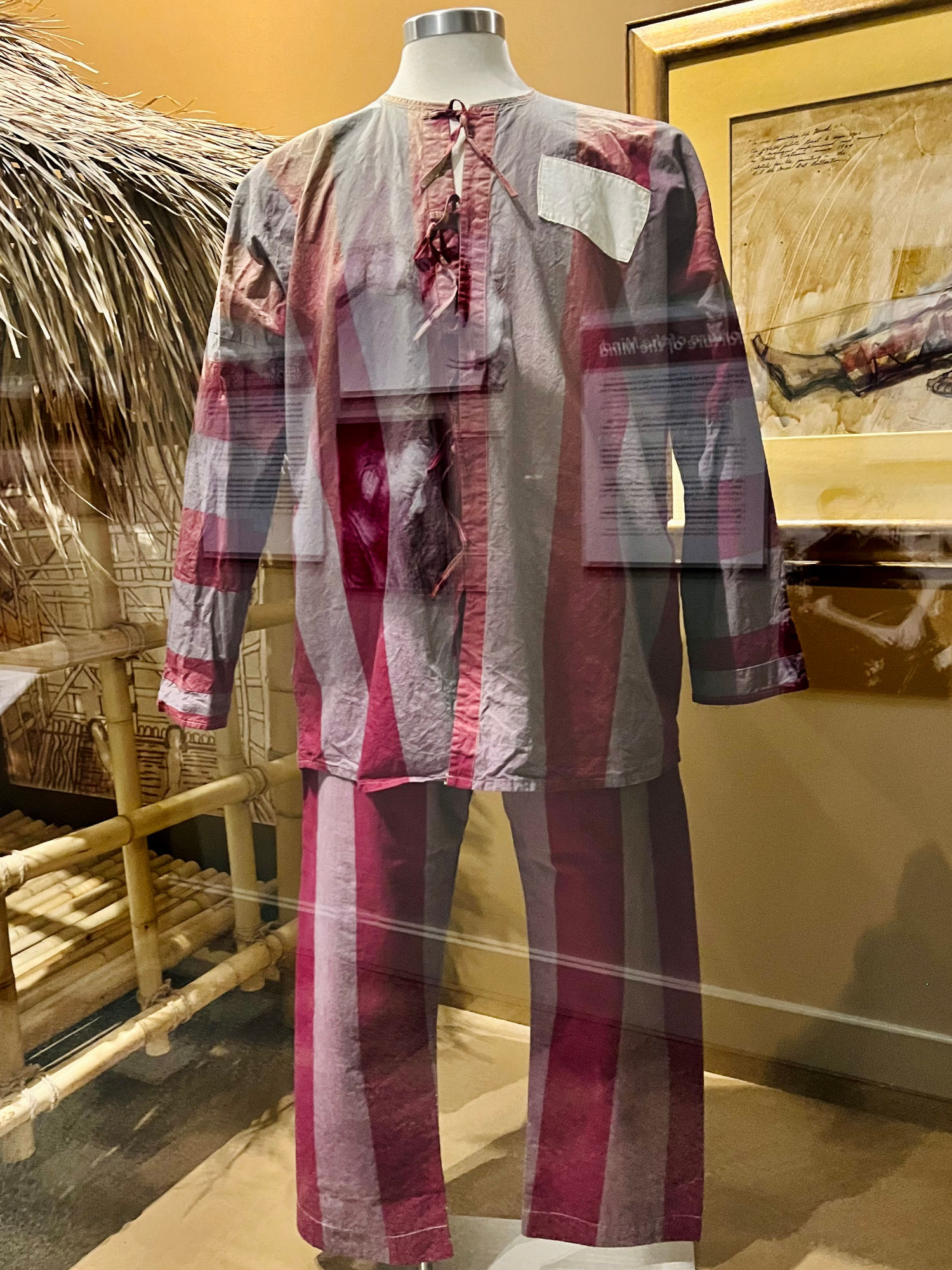
Striped Pajama Set
Standard POW Uniform
From 1961 to 1973, the Viet Cong and North Vietnamese forces imprisoned hundreds of American soldiers in dozens of camps in and around Hanoi. Upon arriving at the camps, captured men were issued two-toned striped pajama sets, which became their standard uniform.
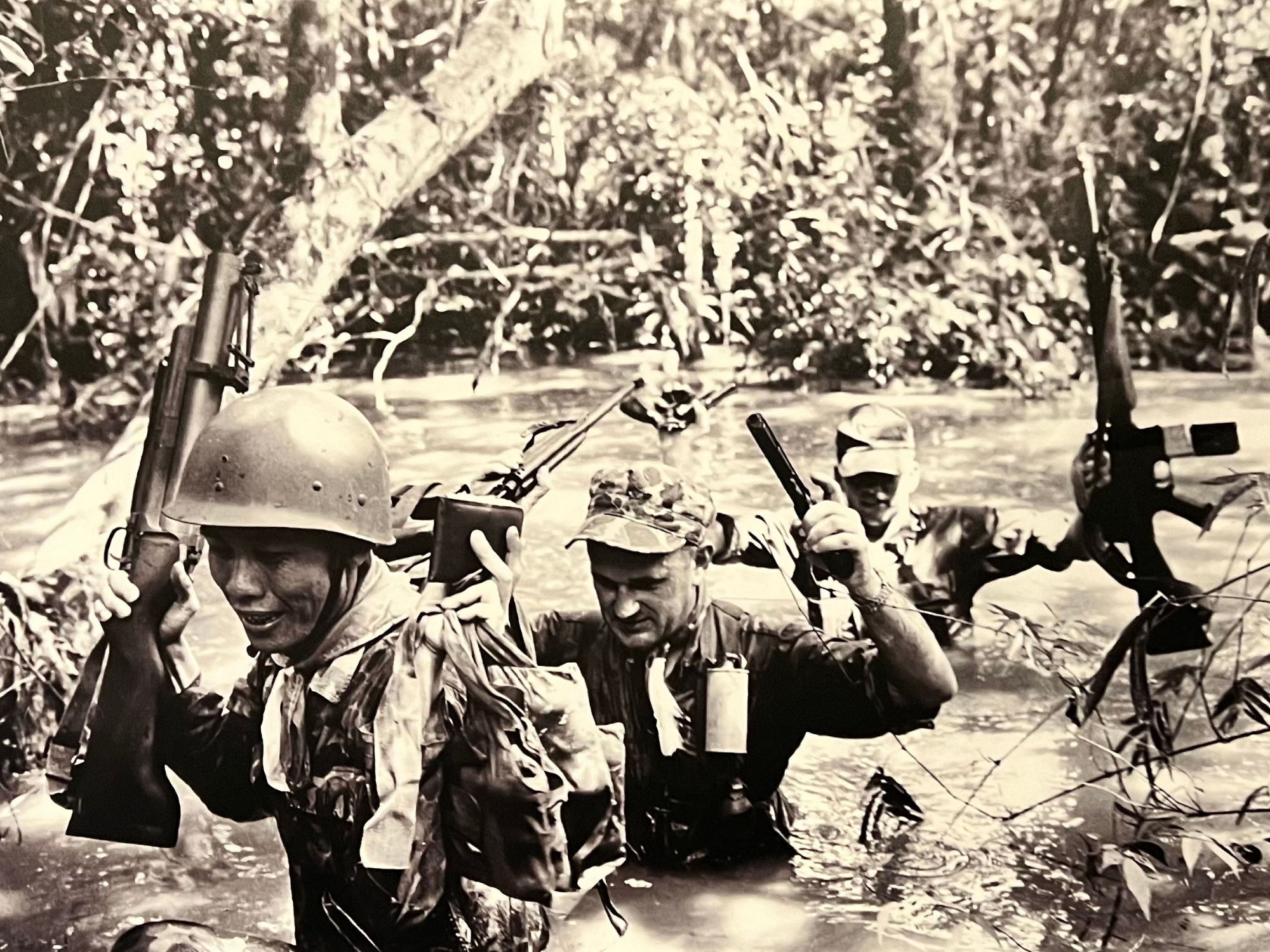
River Patrol
American trained ARVN South Vietnamese troops on a river patrol, accompanied by several American advisors.
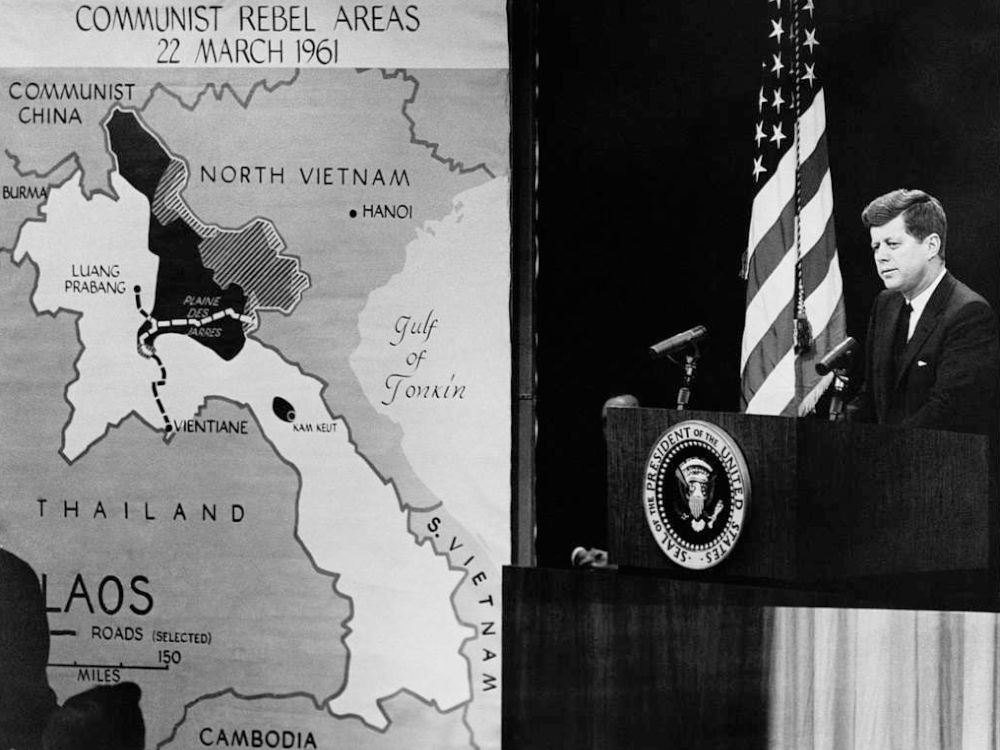
President John F. Kennedy
President Kennedy explains a diagram showing communist incursions into neighboring countries
Eisenhower's successor, President John F. Kennedy, undertook a major expansion of American involvement in Vietnam. During his presidency, the number of American military advisors grew to 16,000.
Kennedy provided the South Vietnamese military with fighter planes, helicopters, and other war material. He authorized the use of napalm and Agent Orange.
The United States encouraged the October 1963 overthrow of South Vietnam's President Diem, who was killed during the coup. Shortly thereafter, President Kennedy said in a dictated memo,
I feel we must bear a good deal of responsibility for it.
The Tiger Cage
Communist forces used cages made of bamboo to lock-up POWs. These cages were sometimes no larger than four feet wide, four feet long, and four feet high. They came to be known as "Tiger Cages" and were used to transport POWs and as a torture device. It was among the most brutal methods of torture.
Chained at the ankle, Tiger Cages were too small for POWs to stand or lie down. They could only crouch. Some prisoners spent months locked in one of these bamboo prison cells. Debilitating injuries to their arm and leg joints were common.
1st Lieutenant Rick Rowe was captured on October 29, 1963 by Viet Cong forces in South Vietnam. He spent 62 months as a prisoner. During much of the time he was kept in a Tiger Cage. Rowe made three unsuccessful attempts to escape. Captured each time, he was brutally tortured.
Sentenced to death by the Viet Cong in 1968, Rowe managed to break away from his captors while being escorted to the place of execution. As he ran to a clearing in the jungle, he was spotted by an American helicopter and rescued. Rowe was one of the 34 POWs who escaped during the Vietnam War.
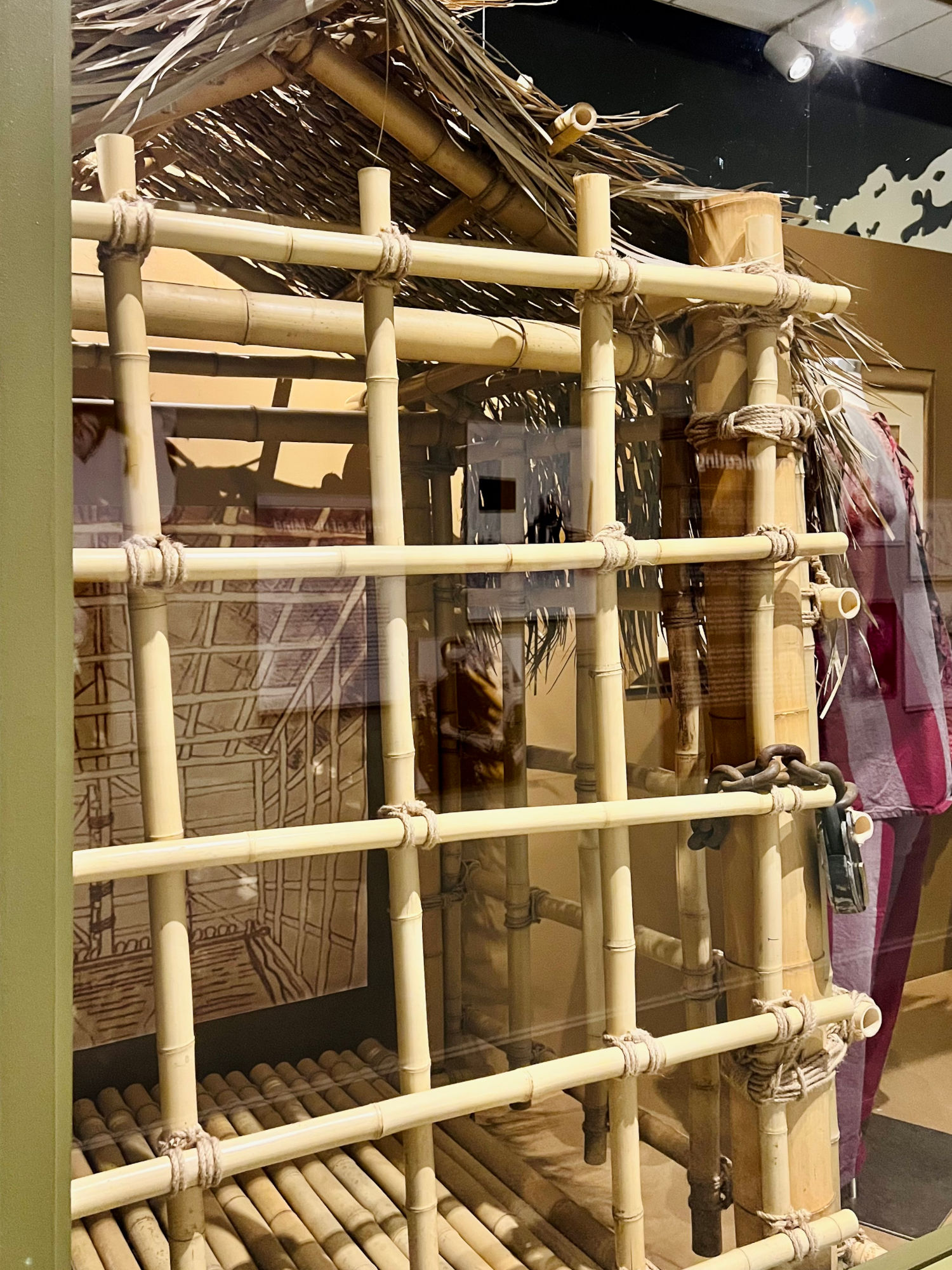
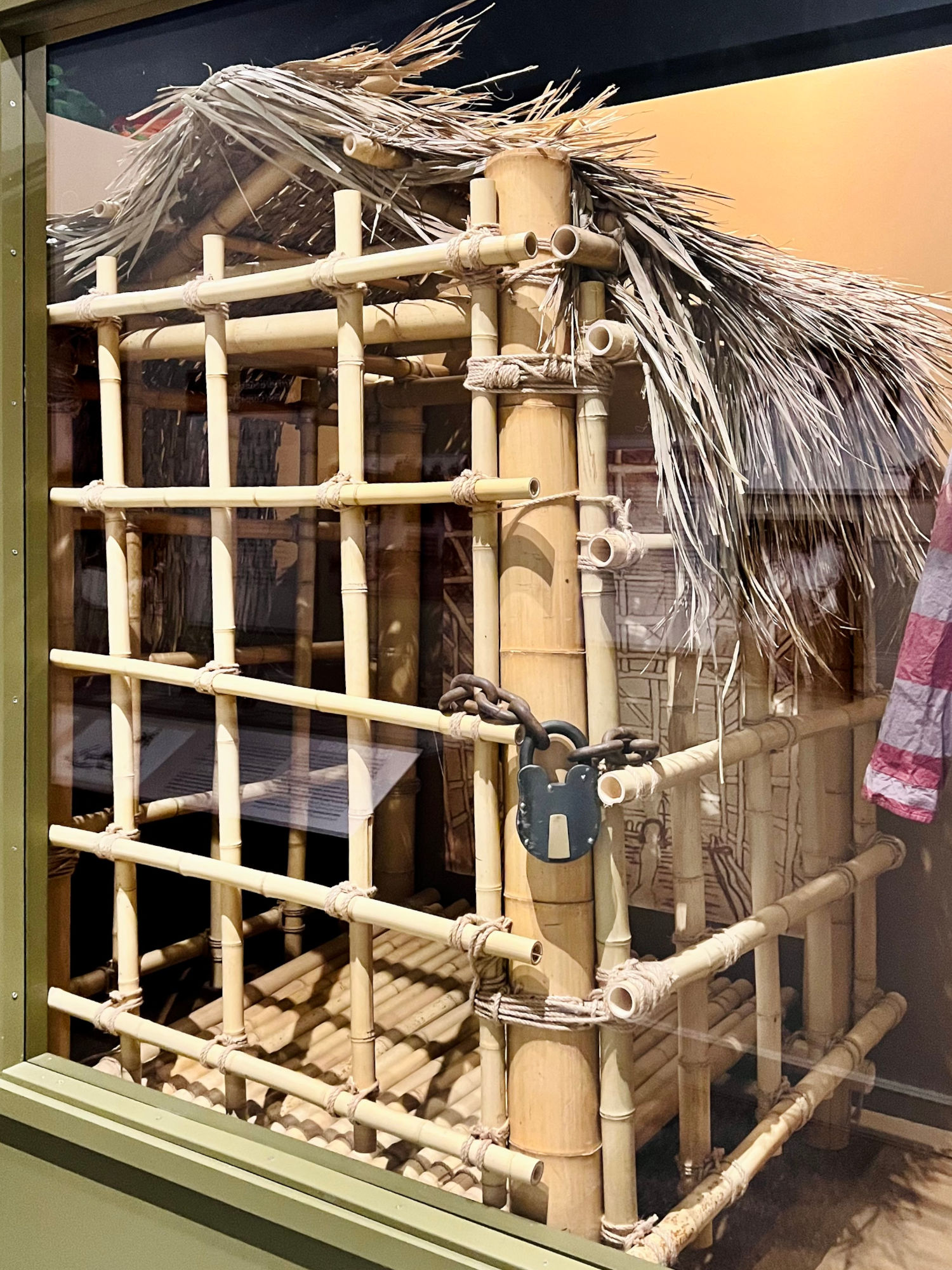
Makeshift Bamboo Cage
The back wall is the drawing
U.S. Army 1st Lieutenant James "Nick" Rowe was captured by Viet Cong forces in South Vietnam on October 29, 1963. Somehow, Rowe was able to keep a hidden diary during his captivity. The diary included this drawing of a makeshift bamboo cage used to hold POWs.
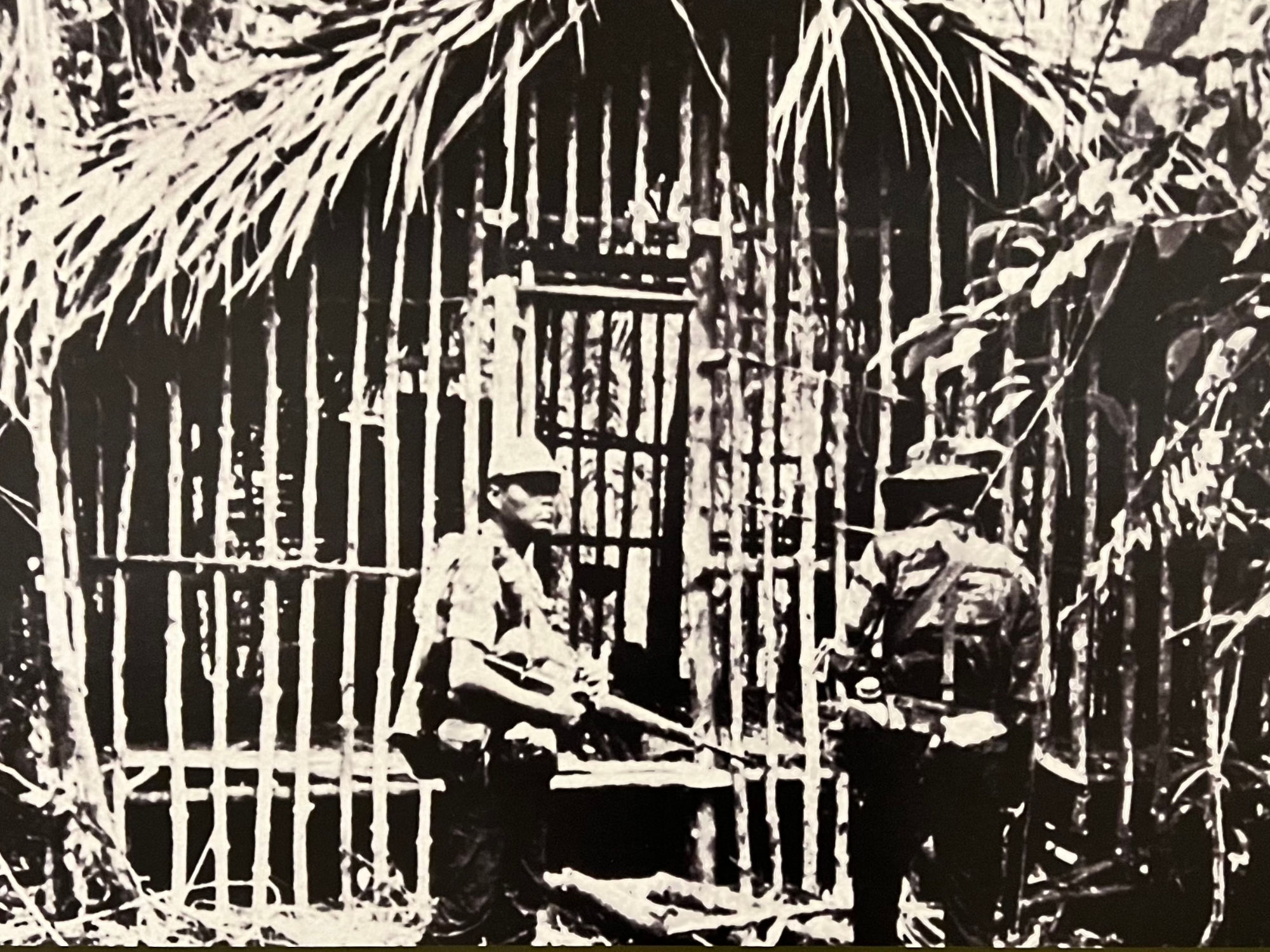
Tiger Cage
A cage-like hut used to imprison POWs. While this cage had a woven roof, the lack of solid walls exposed prisoners to the elements and insects within the jungle.
| PRE-VIETNAM WAR: | |
|---|---|
| THIS PAGE | |
| What is a POW? | |
| 1775 | American Revolution POWs |
| 1812 | War of 1812 POWs |
| 1865 | Civil War POWs |
| 1917 | World War I POWs |
| 1920 | Ho Chi Minh |
| 1941 | World War Ii POWs |
| 1942 | World War II Japanese Internment |
| 1945 | Brief History of Vietnam |
| 1947 | Truman Doctrine |
| 1949 | Geneva Conventions |
| 1950 | Korean War POWs |
| 1954 | Indochina Communist Expansion |
| 1954 | 17th Parallel |
| 1955 | POW Code of Conduct |
| 1963 | Tiger Cages |
| THE NIXON YEARS: | |
|---|---|
| PAGE 3 | |
| 1968 | 1968 Campaign |
| Requirements For Peace | |
| 1969 | Alive or Dead? |
| Ross Perot's Christmas Delivery | |
| 1970 | Missing in Action |
| The Camps | |
| POW / MIA Bracelets | |
| 1971 | Write Hanoi |
| Live From Space | |
| 1972 | Air War in Vietnam |
| Operation Linebacker II | |



